DOI:
10.1039/D0CE01024C
(Highlight)
CrystEngComm, 2020,
22, 6750-6775
The effect of coordinated solvent molecules on metal coordination environments in single-crystal-to-single-crystal transformations
Received
15th July 2020
, Accepted 22nd September 2020
First published on 24th September 2020
Abstract
Single-crystal-to-single-crystal (SCSC) transformation has been demonstrated to provide an ideal platform to explore the formation process of chemical bonds, which is conducive to making function-oriented crystal synthesis a reality. A solvent as a ligand or a structure-directing agent plays a significant role in the structural formation of coordination polymers (CPs), and its removal/adsorption or exchange can affect the change in metal coordination environments. In this article, we provide a brief overview of recent progress in the effect of coordinated solvent molecules on metal coordination environments of CPs in SCSC transformations. We highlight three different categories based on their stimuli conditions, heat treatment, immersion in solvent or mother liquid, and exposure to vapor. We try to discuss the criteria for CPs in which the metal coordination spheres can be affected by the coordinated solvents, which may provide new insights into the rational design and construction of CPs with the desired structures and properties.
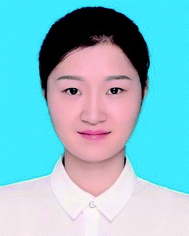 Quan-Quan Li | Dr. Quan-Quan Li was born in Jiangsu, China, in 1990. She received her B.E. degree in 2013 from Yancheng Institute of Technology and then her Ph.D. degree from Northwest University, China. In 2019, she joined the group of Prof. Jin-Xi Song (Northwest University, China) as a postdoctoral fellow focusing on the syntheses and development of coordination polymers with applications in detection and removal of environmental pollutants. |
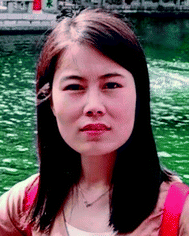 Hua Liu | Hua Liu was born in Shanxi Province, China, in 1994. She received her B.S. degree in 2017 from Shanxi Agricultural University, China. She is now pursuing her Ph.D. degree under the supervision of Prof. Ping Liu (Northwest University, China). Her research focuses on the synthesis and development of new organic chromophore-based luminescent metal organic frameworks with applications as sensors and optoelectronic materials. |
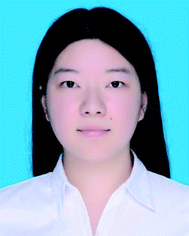 Ting-Ting Zheng | Ting-Ting Zheng was born in Shannxi Province, China, in 1995. She received her B.S. degree in 2018 from Northwest University, China. She is now pursuing her M.D. degree under the supervision of Prof. Ping Liu (Northwest University, China). Her research interests focus on tetrazine functional MOFs. |
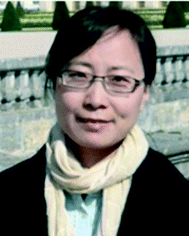 Ping Liu | Prof. Ping Liu was born in Shandong Province, China. She obtained her Ph.D. degree in 2005 from Northwest University, China (Supervisor: Yao-Yu Wang). She joined the group of Prof. Zhensen Wu at Xidian University as a post-doctoral (2006–2010), and in 2011, she was a visiting scholar at the University of Strasbourg, France. Now she is a full professor in Northwest University. Her research interest focuses on rational design and synthesis of coordination polymers and their functional applications. |
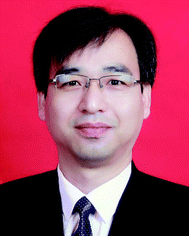 Jin-Xi Song | Prof. Jin-Xi Song was born in Gansu Province, China. He obtained his Ph.D. degree in 2004 in engineering from Xi'an University of Technology, China. During the following two years, he did his post-doctoral research in environmental science and engineering with Academician Changming Liu at the School of Environment, Beijing Normal University, from 2004 to 2005. Now, he is a full professor in the College of Urban and Environmental Sciences at Northwest University. His main research interests are water environment assessment and management, environmental pollution control and protection, etc. |
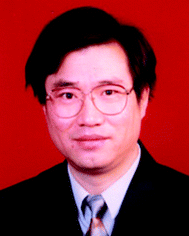 Yao-Yu Wang | Yao-Yu Wang is a professor in the College of Chemistry and Materials Science and Shaanxi Three Qin Scholar Chair Professor at Northwest University. He was engaged in postdoctoral work at Xi'an Institute of Optics and Precision Mechanics of CAS and worked as a senior visiting scholar at National Taiwan University. He is currently the director of the Key Laboratory of Synthetic and Natural Functional Molecule of the Ministry of Education and an editorial member of Chin. J. Inorg. Chem. of CAS. His research interests mainly focus on functional coordination chemistry, crystal engineering, and materials chemistry. |
1. Introduction
Crystal engineering is ultimately aimed to design and synthesize preferable materials with the desired properties as well as controllably regulate the molecular ordering of building blocks, which requires an improved understanding of the formation process of chemical bonds.1–9 In this aspect, single-crystal-to-single-crystal (SCSC) transformations in coordination polymers (CPs) have attracted wide attention.10–18 Such structural transformations can not only create new materials that cannot be directly obtained by traditional synthetic routes but also provide an opportunity to explore the formation process of chemical bonds.3,19–25 In particular, reactions on the metal centres caused by the removal/adsorption or exchange of solvent molecules during structural transformations are commonly accompanied by the breakage and formation of chemical bonds, which provides a good platform to explore the formation process of chemical bonds.26,27
A solvent molecule in the formation process of CPs can play its role as (i) a ligand, (ii) a guest, (iii) both ligand and guest, and (iv) a structure-directing agent, which was discussed by Du and Li.3 As a ligand, solvent molecules containing N or O donor atoms, such as water (H2O), methanol (MeOH), ethanol (EtOH), acetonitrile (MeCN), tetrahydrofuran (THF), N,N′-dimethylformamide (DMF), N,N′-dimethylacetamide (DMA), N-methyl-2-pyrrolidinone (NMP), N,N′-diethylformamide (DEF), benzene, pyridine (py), etc. tend to show different affinities to metal ions, leading to a particular number and disposition of coordination sites that are available for the additional solvent ligands.3,19–21 As a guest molecule, several factors, such as molecule size,28 steric effects,29 being aprotic or protic30 and synergy effects31 are determinative. As a structure-directing agent, even though the solvent molecule is absent in the final product, it indeed influences the crystal growth, crystalline morphology and lattice structure of the product.32 In this article, solvent molecules acting as ligands (types i and iii) or structure-directing agents (type iv) are discussed to study the effect of coordinated solvent molecules on metal coordination environments during structural transformations. We focus on the examples from 2005 to 2020 and find that some factors, including the intrinsic nature of the solvent molecules and metal ions, can affect the structural transformations.33 For example, as shown in Scheme 1a, among all the coordinated solvent molecules involved in this article, the removal/adsorption or exchange of coordinated H2O molecules are the most common, followed by MeOH, DMF, MeCN and EtOH. This is possible because on the one hand, the H2O molecule shows good affinity to border/hard acids (CoII, CuII, MnII, ZnII, LnIII, etc.) which are common metal ions in structural transformations, and on the other hand, most of the solvents used in the reactions contain water. In the experiments of SCSC transformations, the removal of coordinated H2O molecules is usually achieved by heating samples at 80–300 °C in air or vacuum,13,34–37 and solvent and vapor exchanges occur by immersion in the solvent solution/mother liquid at room temperature (RT) or 50–100 °C and exposure to vapor at RT, respectively.33,38–41
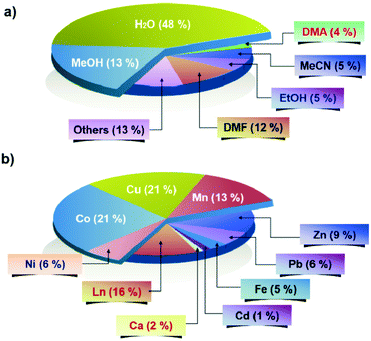 |
| | Scheme 1 The proration of solvent molecules (a) and metal ions (b) in the SCSC transformation involving the changes in metal coordination environments. | |
Removal/adsorption or exchange of coordinated solvent molecules can cause a change in the metal coordination environments in many cases, which occurs in two ways: (I) both coordination number (CN) and coordination geometry (CG) change; (II) CN remains constant, but CG changes. In this article, as depicted in Scheme 2, six types of metal CNs (4–9) and thirteen types of metal CGs have been observed. The metal ions are mainly border acids (CoII, CuII, ZnII, NiII, PbII) and hard acids (MnII, CaII, FeIII, LnIII), as shown in Scheme 1b, in which CoII, CuII, MnII and LnIII are the most common compared to other metal ions and often tend to show affinity to either hard bases (e.g. H2O, MeOH, EtOH, DMF, DMA, etc.) or soft bases (MeCN, etc.).26,33,37,42–44 Thus, it seems that CoII/CuII/MnII/LnIII CPs are excellent candidates for studying the effect of coordinated solvent molecules on the metal coordination environment in SCSC transformations.
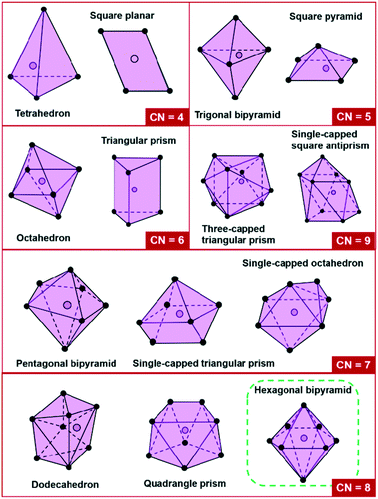 |
| | Scheme 2 The coordination numbers and coordination geometry of metal ions of CPs in this article. Note that the hexagonal bipyramid is not involved in CPs mentioned in this article. | |
Moreover, the changes in the metal coordination environment of CPs may further lead to two kinds of changes in structure: (A) a retention of the framework or supramolecular structure; (B) a drastic movement of the molecular fragments. Commonly, a low-dimensional framework has a structural freedom in regards to the metal ions, while a higher-dimensional framework (e.g. 3D) is sufficiently rigid to prevent recombination of the coordination bonds around the metal ions.13,45 For example, the 1D chains or 2D layers containing chains/spaces can generate a higher-dimensional framework by the movement of 1D chains/2D layers with the reactive functional groups being close and aligned in the correct orientation.45–47 However, for a solvent molecule that acts as a terminal ligand and plays no role in the connection of structures, its removal/adsorption or exchange may not change the framework structure or the arrangement mode of fragments.36,42,48 In addition, the changes in the metal coordination environment of CPs also cause alterations in properties, such as magnetism, luminescence, etc.26 In this article, our observations concern the effect of coordinated solvent molecules on metal coordination environments during SCSC transformations (Table 1), and structural transformations are classified based on stimuli conditions into three general categories: thermal treatment, immersion in solvent solution or mother liquid, and vapor-diffusion technique. Moreover, each category has been divided into two parts of structural conversions (A) and (B).
Table 1 Summary of structural transformations involving the change in metal coordination environments
| Metal ions |
External stimuli |
CP → CP |
Changes in coordinated solvent |
Changes in metal CN |
Changes in metal CG |
Changes in dimensionality |
Ref. |
| CoII |
Heat |
1 ⇌ 2 |
None ⇌ H2O |
4 ⇌ 5 |
Distorted tetrahedron ⇌ distorted trigonal bipyramid |
0D ⇌ 0D |
42
|
| CoII |
Heat |
3 ⇌ 4; 3 → 5; 3 ⇌ 6 |
H2O (3) ⇌ none (4); H2O (3) → MeOH (5); H2O (3) ⇌ EtOH (6) |
6 (CP 3) ⇌ 5 (CP 4); no change for 4→5; 3 ⇌ 6 |
Distorted octahedron (3) ⇌ square pyramid (4) |
2D ⇌ 2D |
48
|
| CoII |
Heat |
7 ⇌ 9; 7 ⇌ 11; 7 → 13 |
H2O (7) ⇌ none (9); H2O (7) ⇌ H2O (11); H2O (7) → D2O (13) |
6 (CP 7) ⇌ 5 (CP 9); 6 (CP 7) ⇌ 5 (CP 11); 6 (CP 7) → 6 (CP 13) |
Distorted octahedron (7) ⇌ square pyramid (9/11) |
2D ⇌ 2D |
34
|
| NiII |
Heat |
8 ⇌ 10; 8 ⇌ 12; 8 → 14 |
H2O (8) ⇌ None (10); H2O (8) ⇌ H2O (12); H2O (8) → D2O (14) |
6 (CP 8) ⇌ 5 (CP 10); 6 (CP 8) ⇌ 5 (CP 12); 6 (CP 8) → 6 (CP 14) |
Distorted octahedron (8) ⇌ square pyramid (10/12) |
2D ⇌ 2D |
34
|
| CoII |
Heat |
15 ⇌ 16 |
H2O ⇌ none |
6 ⇌ 5 |
Distorted octahedron ⇌ square pyramid |
3D ⇌ 3D |
50
|
| CoII |
Heat |
17 ⇌ 18 |
H2O ⇌ none |
6 ⇌ 5 |
Octahedron ⇌ trigonal bipyramid |
3D ⇌ 3D |
51
|
| CoII |
Heat |
19 ⇌ 20 |
H2O ⇌ none |
For Co2: 6 ⇌ 5 |
Distorted octahedron ⇌ trigonal bipyramid |
3D ⇌ 3D |
35
|
| CuII |
Heat |
HKUST-1 → 21 → 22/23/24/25 |
H2O (HKUST-1) → none (CP 21); |
5 (HKUST-1) → 4 (CP 21); |
Square pyramid → square planar |
3D → 3D |
36
|
| DyIII |
Heat |
26 ⇌ 27 |
H2O ⇌ none |
7 ⇌ 6 |
Distorted pentagonal-bipyramid ⇌ trigonal prism |
3D ⇌ 3D |
37
|
| MnII |
Heat |
28 ⇌ 29 |
H2O ⇌ none |
No change (CN = 6) |
Slight changes in trigonal prism |
0D ⇌ 0D |
26
|
| Fe |
Heat |
30 ⇌ 31 |
MeCN/H2O ⇌ H2O |
6 ⇌ 4 |
Distorted octahedron ⇌ tetrahedron |
0D ⇌ 1D |
52
|
| PbII |
Heat |
32 ⇌ 33 |
MeOH ⇌ none |
5 ⇌ 6 |
Square pyramid ⇌ distorted octahedron |
1D ⇌ 2D |
46
|
| PbII |
Heat |
34/35 → 36; 34/35 → 37 |
MeOH (34)/EtOH (35) → none (36); MeOH (34)/EtOH (35) → none (37) |
6 (CP 34)/6 (CP 35) → 5 (CP 36); 6 (CP 34)/6 (CP 35) → 4 (CP 37) |
Distorted triangular prism (34/35) → distorted square pyramid (36) |
1D → 1D |
53
|
| 1D → 2D |
| Distorted triangular prism (34/35) → tetrahedron (37) |
| Metal ions |
External stimuli |
CP → CP |
Changes in coordinated solvent |
Changes in metal CN |
Changes in metal CG |
Changes in dimensionality |
Ref. |
| CoII |
Heat |
38 → 39 ⇌ 40 |
None (38) → H2O (39) ⇌ none (40) |
No change (CN = 6) |
Slight change in distorted octahedron |
1D → 1D |
54
|
| 1D ⇌ 2D |
| CuII |
Heat |
41 → 42 |
H2O → none |
No change (CN = 5) |
Distorted trigonal bipyramid → distorted square pyramid |
1D → 3D |
13
|
| CeIII |
Heat |
43 ⇌ 44 |
H2O ⇌ none |
No change (CN = 8) |
Distorted quadrangle prism ⇌ dodecahedron |
2D ⇌ 3D |
45
|
| CuII |
Heat |
45 ⇌ 46 |
H2O ⇌ none |
6 ⇌ 4 |
Distorted octahedron ⇌ square planar |
2D ⇌ 3D |
55
|
| PbII |
Heat |
47 ⇌ 48 |
H2O ⇌ none |
7 ⇌ 8 |
Distorted single-capped octahedron ⇌ dodecahedron |
3D ⇌ 3D |
56
|
| ZnII |
Heat |
50 ⇌ 51 |
H2O ⇌ H2O |
For Zn1, 6 ⇌ 4 |
For Zn1, octahedron ⇌ distorted tetrahedron |
3D ⇌ 3D |
57
|
| ZnII |
Heat |
52 ⇌ 53 |
DMF ⇌ none |
For Zn2, 6 ⇌ 5 |
For Zn2, distorted octahedron ⇌ distorted square pyramid |
3D ⇌ 3D |
58
|
| MnII |
Solvent solution |
54 ⇌ 55 ⇌ 56 → 54 |
DMF (54) ⇌ DMA (55) ⇌ NMP (56) → DMF (54) |
For Mn1: 6 (CP 54) ⇌ 5 (CP 55) ⇌ 5 (CP 56) → 6 (CP 54) |
For Mn1: distorted octahedron (54) ⇌ distorted square pyramid (55) ⇌ distorted square pyramid (56) |
3D ⇌ 3D |
33
|
| CoII |
Solvent solution |
57 → 58 |
H2O → DMA |
No change (CN = 6) |
Slight change in distorted octahedron |
2D → 2D |
38
|
| CuII |
Solvent solution/mother liquid |
59 ⇌ 60 ⇌ 61; 59 ⇌ 61; 59 ⇌ 62 |
H2O (59) ⇌ DMSO (60) ⇌ MeOH (61); H2O (59) ⇌ MeOH (61); H2O (59) ⇌ MeOH (62) |
No change (CN = 6) |
Slight change in octahedron |
2D ⇌ 2D |
39
|
| CoII |
Solvent solution |
63 → 64 → 65 → 63 |
DMF (63) → MeCN (64) → H2O (65) → DMF (63) |
No change (CN = 6) |
Slight change in distorted octahedron |
2D ⇌ 2D |
49
|
| CdII |
Solvent solution |
66 → 67 |
DMF (66) → DEF (67) |
No change (CN = 6) |
Slight change in distorted octahedron |
2D → 2D |
59
|
| MnII |
Solvent solution |
68 ⇌ 69/70/71/72 |
MeOH (68) ⇌ Xsolvent (Xsolvent = EtOH in 69, MeCN in 70, H2O in 71, ethylene glycol in 72) |
No change (CN = 6) |
Slight change in distorted octahedron |
3D ⇌ 3D |
60
|
| Metal ions |
External stimuli |
CP → CP |
Changes in coordinated solvent |
Changes in metal CN |
Changes in metal CG |
Changes in dimensionality |
Ref. |
| CoII |
Solvent solution |
73 → 74/75/76/77 |
MeOH (73) → Xsolvent (Xsolvent = EtOH in 74, MeCN in 75, H2O in 76, and ethyleneglycol in 77) |
No change (CN = 6) |
Slight change in distorted octahedron |
3D → 3D |
43
|
| ZnII |
Solvent solution |
78 → 79; 78 → 80; 78 → 81 → 82 |
DMSO (78) → DMF (79); DMSO (78) → DMA (80); DMSO (78) → EtOH (81) → H2O (82) |
No change (CN = 5) |
Slight change in square pyramid |
3D → 3D |
61
|
| MnII |
Solvent solution |

|

|
No change (CN = 6) |
Slight change in distorted octahedron |
3D ⇌ 3D |
44
|
| NdIII |
Solvent solution |
88 → 89/90/91/92/93 |
DMF (88) → MeOH (89)/EtOH (90)/acetone (91)/THF (92)/py (93) |
No change (CN = 9) |
Distorted three-capped triangular prism (88) → distorted single-capped square antiprism (89/90/91/92/93) |
3D → 3D |
40
|
| CeIII |
Solvent solution |
94 → 95/96 |
DMF (94) → MeOH (95)/Acetone (96) |
No change (CN = 9) |
Slight change in distorted single-capped square antiprism |
3D → 3D |
41
|
| CuII |
Solvent solution |
97 → 98 |
H2O → none |
No change (CN = 6) |
Slight change in distorted octahedron |
3D → 3D |
64
|
| InIII |
Solvent solution |
99 ⇌ 100 ⇌ 101 ⇌ 99 |
H2O ⇌ MeOH ⇌ H2O ⇌ H2O |
No change (CN = 6) |
Slight change in distorted octahedron |
3D ⇌ 3D |
65
|
| DyIII |
Solvent solution |
102 ⇌ 103 |
DMF ⇌ H2O |
No change (CN = 9) |
Slight change in single-capped square antiprism |
0D ⇌ 0D |
66
|
| EuIII/ TbIII |
Solvent solution/vapor |
104/106 ⇌ 105/107 |
H2O ⇌ DMF |
No change (CN = 9) |
Slight change in a distorted tricapped trigonal prism |
1D ⇌ 0D |
67
|
| CuII |
Mother liquid |
108 → 109 |
H2O → H2O |
4/5 → 6 |
Square planar/distorted square-pyramidal → octahedron |
1D → 2D |
68
|
| MnII |
Solvent solution |
110 → 111 |
None → H2O |
5/6 → 6 |
A distorted square pyramidal coordination (Mn1)/a highly distorted trigonal bipyramidal coordination (Mn3) → octahedron |
2D → 1D |
69
|
| Metal ions |
External stimuli |
CP → CP |
Changes in coordinated solvent |
Changes in metal CN |
Changes in metal CG |
Changes in dimensionality |
Ref. |
| CaII |
Solvent solution |
112 → 113/114 |
H2O (112) → H2O 113/MeOH 114 |
8 (CP 112) → 7 (CP 113/114) |
Dodecahedron (112) → distorted pentagonal bipyramid (113/114) |
2D → 2D |
70
|
| CuII |
Solvent solution |
115 → 116 ⇌ 117 |
None (115) → H2O (116) ⇌ DMF (117) |
No change (CN = 6) |
Slight change in distorted octahedron |
2D ⇌ 2D |
71
|
| ZnII |
Solvent solution |
118 → 119 |
DMF → H2O |
6 → 5 |
Distorted octahedral coordination geometry → distorted trigonal bipyramidal geometry |
2D → 3D |
47
|
| CoII |
Solvent solution |
120 ⇌ 121 |
MeOH ⇌ H2O |
For Co1 and Co2, no change (CN = 6); for Co3, 4 ⇌ 5 |
For Co1 and Co2, slight changes in a distorted octahedron; for Co3, tetrahedral ⇌ square-pyramidal |
3D ⇌ 2D |
72
|
| GdIII |
Solvent solution |
122 ⇌ 123/124/125 |
DMF (122) ⇌ H2O (123)/H2O (124)/DEF (125) |
9 (122) ⇌ 8 (123)/9 (124)/7 (125) |
Three-capped triangular prism (122) ⇌ distorted quadrangle prism (123)/single-capped square antiprism (124)/single-capped triangular prism (125) |
3D ⇌ 3D |
27
|
| MnII |
Solvent solution |
126 ⇌ 127 |
H2O ⇌ H2O |
No change (CN = 6) |
Slight change in distorted octahedron |
3D ⇌ 3D |
73
|
| ZnII |
Mother liquid |
128 → 129 |
H2O → H2O |
6 → 5 |
Distorted octahedron → trigonal bipyramid |
3D→3D |
74
|
| CuII |
Solvent solution |
130 ⇌ 131 |
H2O ⇌ DMF |
No change (CN = 6) |
Slight change in a distorted octahedron |
3D ⇌ 3D |
75
|
| CuII |
Solvent solution |
132 → 133 |
None → H2O |
No change (CN = 6) |
Slight change in a distorted octahedron |
3D → 3D |
76
|
| NiII |
Vapor |
134 ⇌ 135 |
None ⇌ MeOH |
4 ⇌ 6 |
Square-planar ⇌ distorted octahedron |
0D ⇌ 0D |
80
|
| NiII |
Vapor |
136 ⇌ 137 |
MeOH ⇌ H2O |
No change (CN = 6) |
Slight change in a distorted octahedron |
0D ⇌ 0D |
81
|
| CuII |
Vapor |
138 →139 |
MeOH → (S)-ethyl lactate |
No change (CN = 5) |
Slight change in square pyramid |
0D → 0D |
82
|
| Fe |
Vapor |
140 ⇌ 141 |
H2O ⇌ MeOH |
No change (CN = 6) |
Slight change in a distorted octahedron |
0D ⇌ 0D |
83
|
| FeII |
Vapor |
142 ⇌ 143 → 144 ⇌ 142 |
MeCN (142) ⇌ EtOH (143) → H2O (144) ⇌ MeCN (142) |
No change (CN = 6) |
Slight change in a distorted octahedron |
0D ⇌ 0D |
77
|
| 0D → 1D |
| Metal ions |
External stimuli |
CP → CP |
Changes in coordinated solvent |
Changes in metal CN |
Changes in metal CG |
Changes in dimensionality |
Ref. |
| CuII |
Vapor |
145 → 146 |
H2O → none |
No change (CN = 5) |
Slight change in square pyramid |
0D → 0D |
78
|
| CuII |
Vapor |
147 → 148 |
NO3− → H2O |
5 → 6 |
Slightly distorted square pyramid → distorted octahedron |
0D → 1D |
79
|
| CuII |
Vapor |
149 → 150 |
None → H2O |
4 → 5 |
Square planar → distorted square pyramid |
2D → 2D |
14
|
| CuII |
Vapor |
151 ⇌ 152 |
DMSO ⇌ H2O |
5 ⇌ 6 |
Trigonal-bipyramidal ⇌ distorted octahedron |
3D ⇌ 1D |
84
|
2. Transformation by thermal methods
To achieve reactions on the metal centres, thermal methods are often needed to displace the solvent ligands (e.g., H2O, etc.) by other donor species (e.g. py, MeOH, EtOH, etc.).49 The most common methods for solvent removal are heating, evacuation or both. Reverse reactions are carried out by soaking in the appropriate solvent or exposure to vapor. We highlight our observations on dehydration and rehydration or desolvation and resolvation of CPs in this section.
2.1 SCSC transformation with no change in the framework
In this section, we will discuss the structural transformations prompted by heating the single crystals without change in the framework or supramolecular structure.
Pardo et al. reported a reversible and selective single-ion magnet behaviour occurring between a deep red anhydrous [Co(dmbpy)2]·(ClO4)2 (1, dmbpy = 6,6′-dimethyl-2,2′-bipyridine) and an orange hydrated [Co(dmbpy)2(H2O)]·(ClO4)2 (2) (Fig. 1).42 This switching behaviour is related to the coordination and release of a H2O molecule through vapour adsorption and heating, respectively. CPs 1 and 2 crystallize in the monoclinic P21/c space group. In 1, each tetra-coordinated CoII is in a slightly distorted tetrahedral CoN4 environment, whereas it is penta-coordinated in 2, adopting a CoN4O coordination sphere and exhibiting a distorted trigonal bipyramid (τ = 0.44). Even though the CN and CG both change (pathway I) in such a structural transformation, the supramolecular structure and packing mode remain. In addition, a reversible and selective single-ion magnet (SIM) behaviour switch occurs between a “slow-relaxing” 1 and its “fast-relaxing” 2.
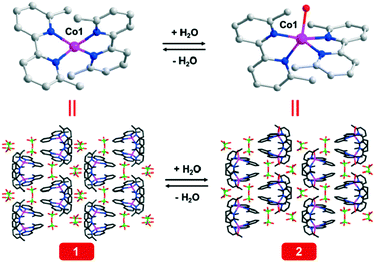 |
| | Fig. 1 Reversible SCSC transformation in 1 and 2. Reproduced with permission from ref. 42. Copyright 2017, the Royal Society of Chemistry. | |
A 2D pillared bilayer [Co(5-NH2-bdc)(bpy)0.5(H2O)]·2H2O (3, 5-NH2-bdc = 5-aminoisophthalate, bpy = 4,4′-bipyridine) exhibits reversible SCSC transformation upon removing and rebinding the coordinated H2O molecules as well as replacing them with MeOH and EtOH (Fig. 2).48 All CPs crystallize in the monoclinic space group P21/c. SC-XRD reveals that the CG of CoII changes from octahedron CoN2O4 in 3 to square pyramid CoN2O3 in dehydrated [Co(5-NH2-bdc)(bpy)0.5] (4), accompanied by shrinkage/expansion of pore deformation with the framework and packing mode of 3 being retained. Moreover, the substitution of the H2O molecule by a MeOH or EtOH molecule results in [Co(5-NH2-bdc)(bpy)0.5(MeOH)]·H2O (5) or [Co(5-NH2-bdc)(bpy)0.5(EtOH)]·H2O (6) without change in the CN of CoII (pathway II) and the network structure.
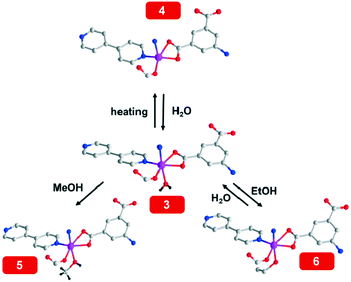 |
| | Fig. 2 Reversible SCSC transformation upon removal and rebinding of coordinating water molecules in 3 and 4. Reproduced with permission from ref. 48. Copyright 2009 American Chemical Society. | |
Natarajan et al. reported two isostructural 2D [Co2(AIP)2(pyz)(H2O)2]·3H2O (7, AIP = 5-aminoisophthalic acid, pyz = pyrazine) and [Ni2(AIP)2(pyz)(H2O)2]·3H2O (8), in which the coordinated and lattice H2O molecules can be removed and inserted by simple heating–cooling cycles under atmospheric conditions (Fig. 3).34 Both 7 and 8 crystallize in the triclinic space group P![[1 with combining macron]](https://www.rsc.org/images/entities/char_0031_0304.gif) , and there are two crystallographically independent MII ions (M = Co and Ni). Both metal ions have a distorted octahedral coordination formed by three carboxylate oxygens, one N from the AIP anion, one N from the pyz ligand, and one coordinated H2O molecule (CN = 6). Heating at 125 °C of 7 and 8 produces the dehydrated 2D [Co2(AIP)2(pyz)] (9) and [Ni2(AIP)2(pyz)] (10), which are also isostructural but undergo a crystal system transformation from parent triclinic (9 and 10) to monoclinic (space group C2/c, 9 and 10). 9 and 10 also retain the structural integrity of the parent phase as there is very little change in the bilayer arrangement. The metal ions are coordinated by three carboxylate oxygens, one N from the AIP anion, and one N from the pyz ligand, forming a distorted square pyramidal environment (MO3N2, CN = 5) (pathway I). When heating at 80 °C, 7 and 8 can transform into [Co2(AIP)2(pyz)(H2O)]·H2O (11) and [Ni2(AIP)2(pyz)(H2O)]·H2O (12), respectively. In 11 and 12, one of the two metal ions loses the coordinated H2O molecule (becomes distorted square pyramidal), while the other metal ion continues to be in the octahedral environment and eventually loses the bonded water molecules when heated to 125 °C. In addition, the water molecules of 7 and 8 can be replaced by D2O when soaking in D2O, producing 13 and 14 without change in metal CN (pathway II), respectively.
, and there are two crystallographically independent MII ions (M = Co and Ni). Both metal ions have a distorted octahedral coordination formed by three carboxylate oxygens, one N from the AIP anion, one N from the pyz ligand, and one coordinated H2O molecule (CN = 6). Heating at 125 °C of 7 and 8 produces the dehydrated 2D [Co2(AIP)2(pyz)] (9) and [Ni2(AIP)2(pyz)] (10), which are also isostructural but undergo a crystal system transformation from parent triclinic (9 and 10) to monoclinic (space group C2/c, 9 and 10). 9 and 10 also retain the structural integrity of the parent phase as there is very little change in the bilayer arrangement. The metal ions are coordinated by three carboxylate oxygens, one N from the AIP anion, and one N from the pyz ligand, forming a distorted square pyramidal environment (MO3N2, CN = 5) (pathway I). When heating at 80 °C, 7 and 8 can transform into [Co2(AIP)2(pyz)(H2O)]·H2O (11) and [Ni2(AIP)2(pyz)(H2O)]·H2O (12), respectively. In 11 and 12, one of the two metal ions loses the coordinated H2O molecule (becomes distorted square pyramidal), while the other metal ion continues to be in the octahedral environment and eventually loses the bonded water molecules when heated to 125 °C. In addition, the water molecules of 7 and 8 can be replaced by D2O when soaking in D2O, producing 13 and 14 without change in metal CN (pathway II), respectively.
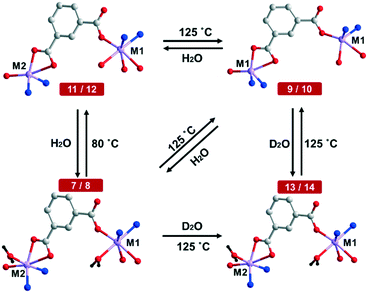 |
| | Fig. 3 The reversible SCSC transformation in CPs 7–14. Reproduced with permission from ref. 34. Copyright 2009, American Chemical Society. | |
Reversible SCSC transformation between hydrated 3D [Co3(L)2(BTEC)(H2O)2]·2H2O (15, HL = 3,5-di(imidazole-1-yl)benzoic acid, H4BTEC = 1,2,4,5-benzenetetracarboxylic acid) and dehydrated 3D [Co3(L)2(BTEC)] (16) upon removing and rebinding the lattice and coordinated H2O molecules was reported by Sun et al. (Fig. 4).50 CP 15 crystallizes in the triclinic P![[1 with combining macron]](https://www.rsc.org/images/entities/char_0031_0304.gif) space group, and both Co1 and Co2 are hexa-coordinated and show a distorted octahedral coordination geometry. Co1 is bonded to six carboxylate O atoms from BTEC4−. The Co2 centre is surrounded by three carboxylate O atoms from BTEC4−, two N atoms from L−, and one water O atom. CP 15 is heated at 160 °C to remove the lattice and coordinated H2O molecules, and CP 16 is obtained with the retention of the framework structure and packing mode, but the coordination geometry of Co2 changes from octahedron (CN = 6) to square pyramid (CN = 5) (pathway I). Furthermore, the dehydrated form 16 exhibits a highly selective adsorption of water molecules over N2, MeOH and EtOH.
space group, and both Co1 and Co2 are hexa-coordinated and show a distorted octahedral coordination geometry. Co1 is bonded to six carboxylate O atoms from BTEC4−. The Co2 centre is surrounded by three carboxylate O atoms from BTEC4−, two N atoms from L−, and one water O atom. CP 15 is heated at 160 °C to remove the lattice and coordinated H2O molecules, and CP 16 is obtained with the retention of the framework structure and packing mode, but the coordination geometry of Co2 changes from octahedron (CN = 6) to square pyramid (CN = 5) (pathway I). Furthermore, the dehydrated form 16 exhibits a highly selective adsorption of water molecules over N2, MeOH and EtOH.
 |
| | Fig. 4 Reversible SCSC transformation upon removal and rebinding of coordinating water molecules in 15 and 16. Reproduced with permission from ref. 50. Copyright 2011, American Chemical Society. | |
Chen et al. reported a 3D porous magnet, [KCo7(OH)3(ip)6(H2O)4]·12H2O (17, H2ip = isophthalic acid), which can undergo a reversible SCSC transformation, a concomitant reversible magnetic change upon desorption/adsorption of guest molecules (Fig. 5).5117 crystallizes in the space group R![[3 with combining macron]](https://www.rsc.org/images/entities/char_0033_0304.gif) c, and there are three crystallographically independent octahedral CoII ions in the asymmetric unit. Co1 is coordinated by three O atoms from ip ligands and three μ3-OH groups; Co2 is surrounded by five oxygen atoms from ip ligands and one μ3-OH group; Co3 is coordinated to four carboxylate oxygen atoms, one μ3-OH group, and one H2O molecule. The K+ counterions are bound to four carboxylate oxygen atoms and two H2O molecules. Single crystals of 17 are heated at 120 °C to obtain dehydrated single crystals of [KCo7(OH)3(ip)6] (18) accompanied by a colour change from red to purple. After the removal of the lattice and coordinated H2O molecules, although the structures are similar, the metal coordination environments in 18 are very different from those in 17. Most remarkably, the octahedral environment of Co3 (CN = 6) in 17 has been changed to a tetrahedron (CN = 5) in 18 (pathway I), and the K+ ion is now only four-coordinated. Note that such a transformation is concomitant with reversible magnetic property change upon desorption/adsorption of guest molecules.
c, and there are three crystallographically independent octahedral CoII ions in the asymmetric unit. Co1 is coordinated by three O atoms from ip ligands and three μ3-OH groups; Co2 is surrounded by five oxygen atoms from ip ligands and one μ3-OH group; Co3 is coordinated to four carboxylate oxygen atoms, one μ3-OH group, and one H2O molecule. The K+ counterions are bound to four carboxylate oxygen atoms and two H2O molecules. Single crystals of 17 are heated at 120 °C to obtain dehydrated single crystals of [KCo7(OH)3(ip)6] (18) accompanied by a colour change from red to purple. After the removal of the lattice and coordinated H2O molecules, although the structures are similar, the metal coordination environments in 18 are very different from those in 17. Most remarkably, the octahedral environment of Co3 (CN = 6) in 17 has been changed to a tetrahedron (CN = 5) in 18 (pathway I), and the K+ ion is now only four-coordinated. Note that such a transformation is concomitant with reversible magnetic property change upon desorption/adsorption of guest molecules.
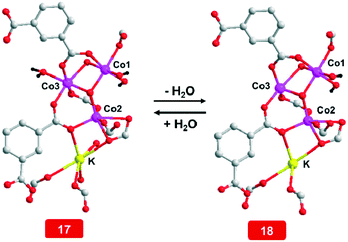 |
| | Fig. 5 Reversible SCSC transformation upon removal and rebinding of coordinating water molecules in 17 and 18. Reproduced with permission from ref. 51. Copyright 2007, Wiley-VCH. | |
Loye et al. reported a reversible SCSC transformation between two isostructural 3D porous CPs, [Co2(ppca)2(H2O)(V4O12)0.5]·3.62 H2O (19, Hppca = 4-(pyridine-4-yl)pyridine-2-carboxylic acid) and [Co2(ppca)2(V4O12)0.5]n (20) in fashion (Fig. 6).35 CP 19 contains two crystallographically independent CoII ions, and Co1 and Co2 are both pseudooctahedral coordination environments. Co1 is bonded to two O atoms from two {V4O12} units, two carboxylate O atoms and two N atoms from ppca. Co2 is likewise coordinated with two carboxylate O atoms and two N atoms from ppca, one O atom from one {V4O12} unit, and one H2O molecule. Single crystals of 19 are heated to 300 °C resulting in 20. After the removal of lattice and coordinated H2O molecules, the CN of Co2 changes from 6 to 5, and the CG converts from an octahedron to a trigonal bipyramidal coordination environment (pathway I). In addition, immersion of 20 into water or exposure to air completely reverses the structural change, reforming 19.
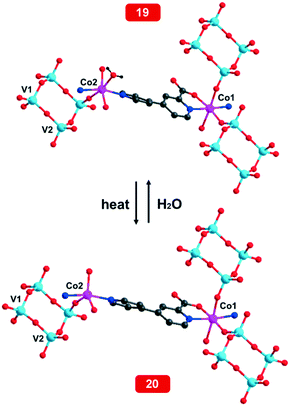 |
| | Fig. 6 Reversible SCSC transformation upon removal and rebinding of coordinating water molecules in 19 and 20. Reproduced with permission from ref. 35. Copyright 2005, Wiley-VCH. | |
HKUST-1 containing CuII paddle wheel-type nodes and 1,3,5-benzenetricarboxylate (H3BTC) features accessible CuII sites to which solvent or other desired molecules can be intentionally coordinated. “Pristine” HKUST-1 was prepared via a solvothermal reaction of copper(II) nitrate and H3BTC in a mixed solvent of H2O and EtOH. This form contains both H2O and EtOH as coordinated molecules. To prepare pure H2O-, EtOH-, MeOH-, or MeCN-coordinated HKUST-1, both coordinated H2O and EtOH are removed via heating at 150 °C for 48 h under flowing N2 and CP 21 is obtained. Then the solvent-free materials are placed in an Ar-charged glovebox and allowed to coordinate H2O (22), EtOH (23), MeOH (24), or MeCN (25) by soaking in the corresponding neat liquid. This transformation includes the breaking of the old Cu–O(H2O/EtOH) and the formation of new Cu–O/N(solvent) without a change in CN (pathway II) (Fig. 7).3622 shows a large enhancement in proton conductivity relative to that of 25 once the material's channels were infused with MeOH.
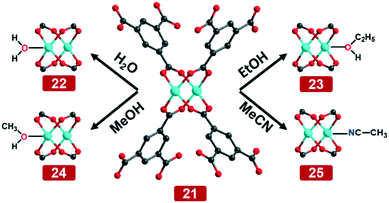 |
| | Fig. 7 The SCSC transformation between dehydrated HKUST-1 (21) and solvent-coordinated HKUST-1 (22–25). Reproduced with permission from ref. 36. Copyright 2012, American Chemical Society. | |
Shi and Li et al. reported the tunable slow magnetic relaxation behaviours driven by sorption or desorption of terminal coordinated water molecules and the guest molecules in structurally similar 3D Dy(BTC)(H2O)·DMF (26) and Dy(BTC) (27) (Fig. 8).3726 crystallizes in the tetragonal space group P4322. The DyIII ion is coordinated by seven oxygen atoms from six carboxylate oxygen atoms of BTC ligands and one terminal H2O molecule, showing a distorted pentagonal–bipyramidal environment. The anhydrous phase of 27 is gained by calcination of 26 under vacuum at 240 °C for 12 h, and the terminal coordinated H2O molecule and guest DMF molecule are removed. The removal of coordinated H2O results in the CG of the DyIII ion changing from pentagonal–bipyramid to a distorted trigonal prism with a change in CN (pathway I). CP 27 can also be transformed to 26 if it is immersed in the mixture of water and DMF. Moreover, the reversible sorption–desorption of terminal coordinated H2O molecules and the guest molecules can switch slow magnetic relaxation.
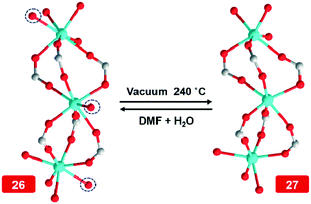 |
| | Fig. 8 The reversible SCSC transformation in 26 and 27. Reproduced with permission from ref. 37. Copyright 2013, the Royal Society of Chemistry. | |
2.2 SCSC transformation with change in the framework
Different from the above-mentioned invariable framework or supramolecular structure, solvent removal or uptake may re-regulate the microscopic combinations of metal ions and ligands and thus result in intense dynamic structural conversions. For example, a reversible SCSC transformation between a trinuclear Mn2Mo molecule [Mn(L)(H2O)]2[Mo(CN)7]·2H2O (28, L = N,N′-bis[(1H-imidazol-4-yl)methylene]-2,2-dimethypropane-1,3-diamine) and a hexanuclear Mn4Mo2 molecule [Mn(L)(H2O)]2[Mn(L)]2 [Mo(CN)7] (29) occurs upon dehydration and rehydration (Fig. 9).26 Heating a green single crystal of 28 at 110 °C under a dynamic vacuum for 3 h produced a brown crystal of 29, which returned to green upon exposure to moisture for 5 h. CPs 28 and 29 crystallize in the monoclinic space groups C2/c and C2/m, respectively. CP 28 possesses hydrogen bonds in two forms, Owater–H⋯NCN− and Owater–H⋯Owater. After the removal of coordinated H2O molecules, new Mn–NCN− bonds are formed without a change in CN (pathway II). The coordination geometry around the MnII is distorted trigonal prism MnN5O and distorted trigonal prism MnN6 in 28 and 29, respectively. In addition, the remarkable change in structure also involves subtle geometry changes of [MoIII(CN)7]4− and alterations in the bridging mode between MoIII and MoII ions and, in turn, modifies the magnetic anisotropy and leads to reversible switching of the single-molecule magnet behaviour.
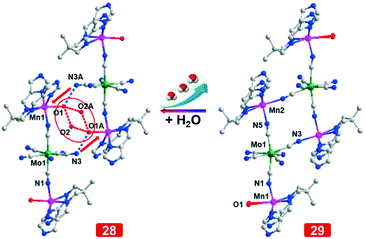 |
| | Fig. 9 The reversible SCSC transformation in 28 and 29. Reproduced with permission from ref. 26. Copyright 2017, American Chemical Society. | |
Reversible SCSC transformation between hexanuclear cluster {[FeIII(Tp)(CN)3]4·[FeII(MeCN)(H2O)2]2}·10H2O·2MeCN (30, Tp = hydrotris(pyrazoly)borate) and 1D [FeIII(Tp)(CN)3]4FeII(H2O)2FeII (31) can be obtained by heat treatment or in solvent vapors (Fig. 10).5230 crystallizes in the P21/c space group, and there are three crystallographically independent Fe ions. The hexa-coordinated Fe1 or Fe3 (FeIII) center is bonded to three N atoms from a Tp ligand and three CN−, showing a slightly distorted octahedron. Fe2 (FeII) is octahedrally coordinated by three CN−, two water molecules and one MeCN molecule. In the hexanuclear unit, two bidentate [Fe(Tp)(CN)3]− anions link two FeII ions through CN− bridges, forming an [FeIII2FeII2(CN)4]6+ square unit. The other two [Fe(Tp)(CN)3]− anions are monodentate and bond to two FeII ions with cis–trans geometry with respect to the bridging [Fe(Tp)(CN)3]− anion. 31 was obtained by slowly heating crystals of 30 at 150 °C under a N2 atmosphere, and this transformation accompanies the change in chirality from achiral 30 to chiral 31. CP 31 crystallizes in the C2 space group, and within the chain, each [Fe(Tp)(CN)3]− entity acts as a bidentate ligand toward two FeII ions (octahedrally coordinated Fe3 and tetrahedrally coordinated Fe4) via two of its three cyanide groups in cis positions, affording bimetallic double chains. Each FeII is coordinated to four N atoms from CN−, and the two remaining sites of Fe3 are occupied by two water molecules. Note that the magnetic conversion between antiferromagnetism (30) and ferrimagnetism (31) has been observed during the structural transformations.
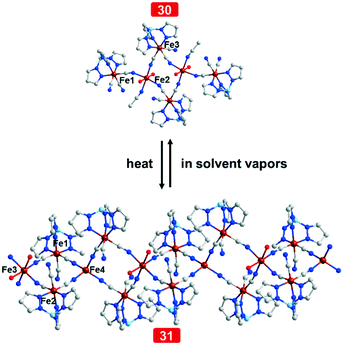 |
| | Fig. 10 The reversible SCSC transformations in 30 and 31. Reproduced with permission from ref. 52. Copyright 2009, American Chemical Society. | |
Morsali et al. reported a reversible thermally induced SCSC transformation between a 1D chain [Pb2(8-Quin)2(NO3)2(MeOH)] (32, 8-HQuin = 8-hydroxyquinoline) and a 2D layer [Pb(8-Quin)(NO3)] (33) (Fig. 11).46 This process is accompanied by a change in the crystallographic point group, from a triclinic P![[1 with combining macron]](https://www.rsc.org/images/entities/char_0031_0304.gif) to a monoclinic P21/c space group. In 32, there are two crystallographically independent PbII ions and both Pb1 and Pb2 are penta-coordinated. Pb1 is surrounded by three O atoms and one N atom from three 8-Quin ligands and one terminal NO3− anion, leading to a distorted square pyramid. Pb2 is bonded to two O atoms and one N atom from two 8-Quin ligands, one terminal NO3− anion, and one MeOH molecule, resulting in a distorted square pyramid. Upon heating at 165–170 °C, a new Pb–Onitrate bond is formed as a result of the CN change from 5 to 6 upon removal of MeOH (pathway I). In 33, each Pb center is hexa-coordinated by two O atoms and one N atom from two 8-Quin ligands, and three O atoms from two NO3− anions, resulting in a distorted octahedron coordination geometry. Such a transformation is also accompanied by a change in colour, dimension, phase and photoluminescence features.
to a monoclinic P21/c space group. In 32, there are two crystallographically independent PbII ions and both Pb1 and Pb2 are penta-coordinated. Pb1 is surrounded by three O atoms and one N atom from three 8-Quin ligands and one terminal NO3− anion, leading to a distorted square pyramid. Pb2 is bonded to two O atoms and one N atom from two 8-Quin ligands, one terminal NO3− anion, and one MeOH molecule, resulting in a distorted square pyramid. Upon heating at 165–170 °C, a new Pb–Onitrate bond is formed as a result of the CN change from 5 to 6 upon removal of MeOH (pathway I). In 33, each Pb center is hexa-coordinated by two O atoms and one N atom from two 8-Quin ligands, and three O atoms from two NO3− anions, resulting in a distorted octahedron coordination geometry. Such a transformation is also accompanied by a change in colour, dimension, phase and photoluminescence features.
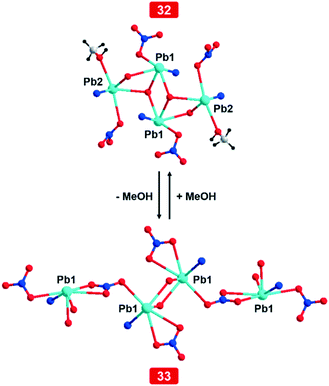 |
| | Fig. 11 The reversible SCSC transformations in 32 and 33. Reproduced with permission from ref. 46. Copyright 2008, the Royal Society of Chemistry. | |
They also reported a reversible transformation of 1D [Pb2(Q-2-c)2(OAc)2(MeOH)2]n (34, Q-2-c− = quinoline-2-carboxylate) and 1D [Pb2(Q-2-c)2(OAc)2(EtOH)2]n (35) to 1D [Pb2(Q-2-c)2(OAc)2]n (36) upon thermal desolvation of coordinated solvent molecules (Fig. 12).53 In addition, irreversible transformations of 34, 35 and 36 to 2D [Pb2(Q-2-c)2]n (37) have been observed in H2O. All the CPs crystallize in the monoclinic P21/c space group. The coordination environments of PbII in these transformations are PbO5N for 34 and 35 (CN = 6, CG = a distorted triangular prism), PbO4N for 36 (CN = 5, CG = a distorted pentahedron) and PbO2N2 for 37 (CN = 4, CG = tetrahedron) (pathway I).
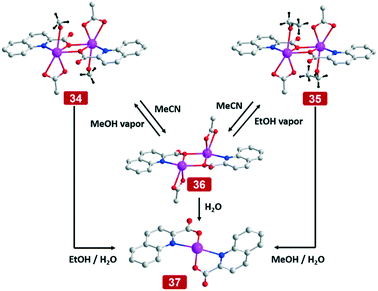 |
| | Fig. 12 The SCSC transformations in 34, 35, 36 and 37. Reproduced with permission from ref. 53. Copyright 2013, the Royal Society of Chemistry. | |
Huang et al. reported a SCSC transformation between three CPs, [Co(1,4-NDC)(5,5′-dmbpy)]n (1D CP 38 and 2D CP 40) and 1D {[Co(1,4-NDC)(5,5′-dmbpy)(H2O)2]2}n (39) (1,4-NDCH2 = 1,4-naphthalenedicarboxylic acid, 5,5′-dmbpy = 5,5′-dimethyl-2,2′-dipyridyl) (Fig. 13).54 Both 38 and 39 crystallize in the triclinic space group P![[1 with combining macron]](https://www.rsc.org/images/entities/char_0031_0304.gif) . CP 38 can transform to 39 upon stirring in water. In 38, each hexa-coordinated CoII adopts a distorted CoO4N2 octahedral geometry consisting of DNC oxygen atoms and 5,5′-dmbpy N atoms. Upon the attack of H2O, the Co–O bonds break while two H2O molecules coordinate to each CoII to fill the vacant sites to maintain the coordination geometry of CoII; finally, the 1D ladder-like chain in 38 splits into two 1D single chains in 39. In 39, there are two crystallographically independent CoII ions, and both of them are in a distorted octahedral coordination environment consisting of two 5,5′-dmbpy N atoms and two water O atoms in the equatorial plane and two DNC oxygen atoms in the axial sites. CP 39 can transform to 40 by heating in its mother solution produced by MW, and 40 can convert into 39 by stirring in its mother solution at room temperature. 40 crystallizes in the space group Pbca, and its asymmetric unit is similar to that of 38.
. CP 38 can transform to 39 upon stirring in water. In 38, each hexa-coordinated CoII adopts a distorted CoO4N2 octahedral geometry consisting of DNC oxygen atoms and 5,5′-dmbpy N atoms. Upon the attack of H2O, the Co–O bonds break while two H2O molecules coordinate to each CoII to fill the vacant sites to maintain the coordination geometry of CoII; finally, the 1D ladder-like chain in 38 splits into two 1D single chains in 39. In 39, there are two crystallographically independent CoII ions, and both of them are in a distorted octahedral coordination environment consisting of two 5,5′-dmbpy N atoms and two water O atoms in the equatorial plane and two DNC oxygen atoms in the axial sites. CP 39 can transform to 40 by heating in its mother solution produced by MW, and 40 can convert into 39 by stirring in its mother solution at room temperature. 40 crystallizes in the space group Pbca, and its asymmetric unit is similar to that of 38.
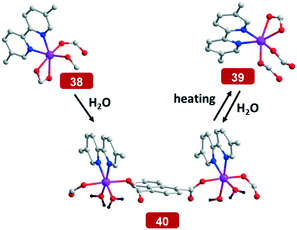 |
| | Fig. 13 Coordination environments of CoII in 38, 40 and 39 that resulted in the exchange of framework. Reproduced with permission from ref. 54. Copyright 2014, American Chemical Society. | |
It has been demonstrated that 1D chains/2D layers containing spaces can generate a 3D framework by the movement of 1D chains/2D layers with the reactive functional groups being close and aligned in the correct orientation.13,45 For example, we reported a 1D hydrated {[CuL0.5(H2O)]·H2O}n (41, H4L = 2,2′-bipyridine-3,3′,6,6′-tetracarboxylic acid), which undergoes an irreversible thermally triggered SCSC transformation to produce the 3D anhydrous [CuL0.5]n (42) (Fig. 14).13 Structural analyses reveal that in 42, though the initial 1D chain is still retained as in 41, accompanied by the Cu-bound H2O removal and a new Ocarboxylate–Cu bond forming, the CG around the CuII ions vary from a distorted trigonal bipyramid to a distorted square pyramid without a change in CN (pathway II). Both 41 and 42 crystallize in the monoclinic space group C/2c. In 41, each CuII ion is in a penta-coordinated CuO4N environment with O from a terminal H2O and N from one L4− ligand located at the axial positions. After the removal of the coordinated H2O molecule, the unsaturated carboxylate O (O4) moves and compensates for the vacancy of the activated Cu centre to form a stable 3D framework 42. With the drastic structural transition, significant prominent changes are observed. Magnetic analyses show prominent changes from antiferromagnetism to weak ferromagnetism due to the new formed Cu1–O–C–O–Cu4 bridge. The catalytic results demonstrate the activation temperature of 41 is higher than that of 42.
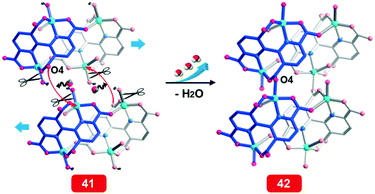 |
| | Fig. 14 The irreversible thermally triggered SCSC transformation in 41 and 42. Reproduced with permission from ref. 13. Copyright 2015, Wiley-VCH. | |
Kitagawa et al. reported a 2D {[Ce(tci)(H2O)2]·2H2O}n (43, H3tci = tris(2-carboxyethyl) isocyanurate) with variable and high coordination numbers of lanthanide metal ions, which can provide more structural freedom to facilitate the transformation to a 3D structure [Ce(tci)]n (44) (Fig. 15).45 Both 43 and 44 crystallize in the triclinic space group P![[1 with combining macron]](https://www.rsc.org/images/entities/char_0031_0304.gif) . In 43, each octa-coordinated CeIII ion is surrounded by six carboxylate oxygen atoms from tci and two H2O molecules to give an overall distorted quadrangle prism. When 43 is heated at 150 °C, it loses all the H2O molecules and converts into the anhydrous product 44. After the removal of the lattice and coordinated H2O molecules, the cleavage of two Ce–Owater bonds and the formation of two new bonds (Ce–O3 and Ce–O4) occurred with the rearrangement of two additional bonds from one CeIII to the other (O5 and O9) without a change in CN (pathway II). The carboxylate oxygen atom (O9) is the key atom in the structural transformation from the 2D sheet to the 3D framework. The O9–Ce bond of one 2D sheet breaks and a bond reforms through coordination with the Ce centre of the next sheet, leading to the formation of the 3D structure. Thus, in 44, each CeIII ion is surrounded by eight oxygen atoms from tci ligands to result in a dodecahedron. In addition, 44 can also transform to 43 under H2O vapor.
. In 43, each octa-coordinated CeIII ion is surrounded by six carboxylate oxygen atoms from tci and two H2O molecules to give an overall distorted quadrangle prism. When 43 is heated at 150 °C, it loses all the H2O molecules and converts into the anhydrous product 44. After the removal of the lattice and coordinated H2O molecules, the cleavage of two Ce–Owater bonds and the formation of two new bonds (Ce–O3 and Ce–O4) occurred with the rearrangement of two additional bonds from one CeIII to the other (O5 and O9) without a change in CN (pathway II). The carboxylate oxygen atom (O9) is the key atom in the structural transformation from the 2D sheet to the 3D framework. The O9–Ce bond of one 2D sheet breaks and a bond reforms through coordination with the Ce centre of the next sheet, leading to the formation of the 3D structure. Thus, in 44, each CeIII ion is surrounded by eight oxygen atoms from tci ligands to result in a dodecahedron. In addition, 44 can also transform to 43 under H2O vapor.
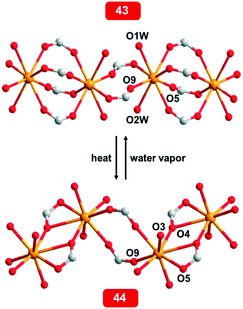 |
| | Fig. 15 The reversible SCSC transformations between 43 and 44. Reproduced with permission from ref. 45. Copyright 2007, Wiley-VCH. | |
Furthermore, they also reported a reversible SCSC transformation between 2D hydrated {[Cu2(tci)(OH)(H2O)3]·1.5H2O}n (45) and 3D anhydrous {[Cu2(tci)(OH)]2}n (46) (Fig. 16).55 CP 45 crystallizes in the monoclinic space group P21/n, and there are three crystallographically independent hexa-coordinated CuII ions with two different coordination environments. The Cu1 centre is bound to two carboxylate oxygen atoms, two μ2-O atoms, one μ3-O atom, and one terminal H2O molecule. The Cu2 or Cu3 centre is surrounded by two carboxylate oxygen atoms, two μ2-O atoms, and two μ3-O atoms. Upon heating at 125 °C, the 2D structure 45 can transform to 3D framework 46. 46 crystallizes in the triclinic space group P![[1 with combining macron]](https://www.rsc.org/images/entities/char_0031_0304.gif) , and compared to 45, there are two similar but crystallographically distinct trinuclear CuII repeating units. The coordination environment around the CuII centres is changed, and all of them are changed from hexa-coordinated octahedral to tetra-coordinated square planar. All the coordinated H2O molecules are removed and the bridged hydroxy (O10) between Cu2 and Cu3 is cleaved. The μ3-O10 atoms are transformed to μ2-O10 atoms between Cu1 and Cu3, isolating Cu2 in terms of direct bridging by a single atom. In 46, the free carboxylate oxygen atoms (O4 and O5) of one 2D sheet are coordinated to Cu1 and Cu2 of the adjacent sheets on both sides, resulting in the transformation of the 2D sheets to the 3D framework. Such a reversible structural transformation is accompanied by a change in magnetic behaviour. The dry phase of 45 can absorb H2O molecules, but rejects organic solvents, such as MeOH, EtOH, acetone, and tetrahydrofuran.
, and compared to 45, there are two similar but crystallographically distinct trinuclear CuII repeating units. The coordination environment around the CuII centres is changed, and all of them are changed from hexa-coordinated octahedral to tetra-coordinated square planar. All the coordinated H2O molecules are removed and the bridged hydroxy (O10) between Cu2 and Cu3 is cleaved. The μ3-O10 atoms are transformed to μ2-O10 atoms between Cu1 and Cu3, isolating Cu2 in terms of direct bridging by a single atom. In 46, the free carboxylate oxygen atoms (O4 and O5) of one 2D sheet are coordinated to Cu1 and Cu2 of the adjacent sheets on both sides, resulting in the transformation of the 2D sheets to the 3D framework. Such a reversible structural transformation is accompanied by a change in magnetic behaviour. The dry phase of 45 can absorb H2O molecules, but rejects organic solvents, such as MeOH, EtOH, acetone, and tetrahydrofuran.
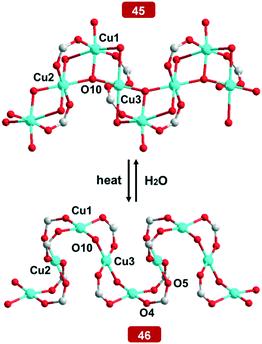 |
| | Fig. 16 The reversible SCSC transformations between 45 and 46. Reproduced with permission from ref. 55. Copyright 2008, Wiley-VCH. | |
3D hydrated [Pb(4-pyc)2(H2O)]n (47, 4-pyc = 4-pyridinecarboxylic acid) can convert into 3D anhydrous [Pb(4-pyc)2]n (48) upon heating at 100–110 °C, and 48 retransforms to 47 when exposed to water vapor (Fig. 17).56 CPs 47 and 48 crystallize in monoclinic space groups Cc and orthorhombic space groups Pbcn, respectively. 47 possesses hydrogen bonds in two forms of Owater–H⋯Npyc and Owater–H⋯Opyc. After the removal of coordinated H2O molecule, new Pb–Npyc and Pb–Opyc bonds are formed with change in CN (pathway I). The coordination geometry around the PbII is distorted single-capped octahedron PbNO6 and dodecahedron PbN2O6 in 47 and 48, respectively.
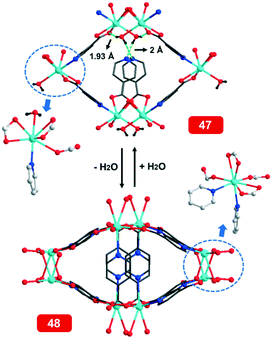 |
| | Fig. 17 The reversible SCSC transformations between 47 and 48. Reproduced with permission from ref. 56. Copyright 2008, the Royal Society of Chemistry. | |
Two 3D CPs, [ZnNa(BTC)(H2O)2]·H2O (49) and [Zn3Na2(BTC)2(HCOO)2(H2O)8] (50), show reversible dehydration–rehydration behaviours (Fig. 18).57 The single crystal of dehydrated 49 cannot be obtained despite many attempts, but 50 retains single crystallinity when dehydrated at 80 °C and gives the dried form [Zn3Na2(BTC)2(HCOO)2(H2O)2] (51). 50 crystallizes in the monoclinic space group C2/c, and there are two independent ZnII and one NaI. The Zn1 centre lying at the 2-fold axis connects two carboxylate O atoms, one μ2-O atom and three terminal H2O molecules, forming a six-coordinated octahedron. Each Zn2 centre shows a tetra-coordinated tetrahedron configuration composed of two carboxylate O atoms from BTC ligands, one carboxylate O atom from one 2.2 formate ion, and one terminal H2O molecule. Na1 ions also exhibit a hexa-coordinated mode to form distorted octahedra bound with two carboxylate O atoms from BTC, one μ2-O atom and two terminal H2O molecules. 51 retains the monoclinic crystal system and the C2/c space group. The Zn1 centre is coordinated by four carboxylate O atoms, showing a distorted tetrahedral geometry. Zn2 has a similar coordination environment to that in 50. Interestingly, there are two NaI centres (Na1A and Na1B) in 51, both lying at the 2-fold axes and exhibiting distorted octahedra bound with four carboxylate O atoms from BTC ligands and two formate O atoms. During this transition process, the coordination environment of the Zn1 centre is changed due to the loss of the coordinated water molecules, while that of Zn2 is preserved. In addition, one crystallographically independent Na1 in 50 changes to two crystallographically independent Na1A and Na1B in 51 (pathway I).
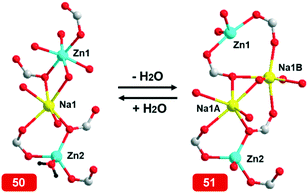 |
| | Fig. 18 The reversible SCSC transformations between 50 and 51. Reproduced with permission from ref. 57. Copyright 2011, American Chemical Society. | |
Kim et al. reported that a 3D [Zn7O2(NBD)5(DMF)2] (52, NBD = 2-nitrobenzene-1,4-dicarboxylate) can reversibly convert to a doubly interpenetrating 3D [Zn7O2(NBD)5] (53), which is triggered by the removal or addition of coordinated DMF molecules (Fig. 19).58 They both crystallize in the monoclinic space group C2/m, and there are three independent ZnII ions. In 52, there is a heptanuclear [Zn7O2(CO2)10(DMF)2] SBU, and the two DMF molecules are the terminal ligands on two different Zn centres. For 52, the hexa-coordinated Zn1 centre shows an octahedral coordination geometry constituted by four carboxylate oxygen atoms and two μ3-O atoms. The Zn2 atom is coordinated by four carboxylate oxygen atoms, one μ3-O atom and one DMF oxygen atom, showing a distorted octahedron. Tetra-coordinated Zn3 is bonded to three carboxylate oxygen atoms and one μ3-O atom, showing a tetrahedron coordination geometry. For 53, Zn1 and Zn3 have a similar coordination environment to that of 52. The removal of DMF makes the CN of Zn2 change from 6 to 5, and Zn2 in 53 shows a distorted square pyramid.
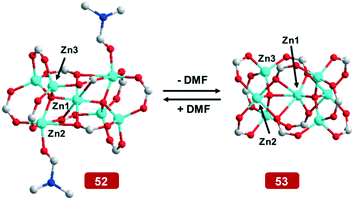 |
| | Fig. 19 The reversible SCSC transformations between 52 and 53. Reproduced with permission from ref. 58. Copyright 2012, Wiley-VCH. | |
3. Transformation by immersing in solvent or mother liquid
In the above-mentioned thermally induced SCSC transformations, the substituting donors located external or preassembled locations around the metal centre within the host network can easily attack the vacant sites of activated metal ions, inducing the structural transformation.49 By contrast, it remains a challenge to engage externally introduced guest ligands to affect the substitution process at the metal centre. Although a larger number of solvent-induced SCSC transformations have been reported in the literature, those involving changes in the metal coordination environment are comparatively much less in number.27 In this section, we will highlight our observations on the effect of coordinated solvent molecules on the metal coordination environments during the structural transformations induced by immersing in solvent or mother liquid.
3.1 SCSC transformation with no change in the framework
The coordination polymers possess high stability in air and weakly bound solvent ligands that can be easily removed and inserted without collapse of the frameworks.33 Such solvent exchange induced transformations might be a way to predict structural information for the new CPs. For example, we previously reported three similar MnII CPs, {[Mn2(nbtc)(H2O)2(S)]·S·0.5H2O}n [S = DMF (54), DMA (55), and NMP (56)] (H4nbtc = 6,6′-dinitro-2,2′,4,4′-biphenyl tetracarboxylic acid), and they crystallize in the monoclinic space group C2/c and exhibit unique 3D double-walled open frameworks with 1D parallelogram channels (Fig. 20).33 Among them, 54–56 show solvent-induced SCSC transformations, and only the coordinated and guest carbonyl solvent molecules (DMF, DMA, NMP) are exchanged. Due to the different steric hindrance of coordinated carbonyl solvent molecules, the structural differences of 54–56 primarily show on the coordination mode of water O1W and the coordination sphere of Mn1/Mn2 between 54 and 55 (56). In 54, both hexa-coordinated Mn1 and Mn2 centres show distorted octahedron geometries. Mn1 is bonded to four oxygen atoms from four nbtc4− and two axial oxygen atoms from one μ2-H2O bridge (O1W) and one terminal water molecule (O2W). Mn2 is coordinated with four oxygen atoms from three nbtc4−, one μ2-H2O bridge (O1W) and one terminal DMF oxygen atom. The crystal structures of 55 and 56 are similar to that of 54 except that the coordinated DMF molecules change into DMA and NMP, respectively, and in 55 and 56, the bridging water in 54 turns into a terminal ligand. Thus, the coordination numbers of Mn1 decrease from 6 to 5 (pathway I), so that the configuration of Mn1 changes from a distorted octahedron in 54 into a distorted tetragonal pyramid in 55/56.
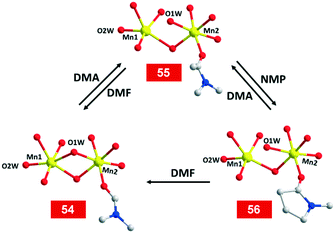 |
| | Fig. 20 Solvent-induced SCSC transformation in 54–56. Reproduced with permission from ref. 33. Copyright 2017, American Chemical Society. | |
He et al. reported a solvent-induced SCSC transformation between two 2D CoII CPs: [Co3(L)2(H2O)4]·2DMF (57, L = 5-(3-carboxybenzyoxy)-isophthalic acid) → [Co3(L)2(DMA)2(H2O)2]·2DMA (58), which occurred by soaking 57 in DMA solution (Fig. 21).38 SC-XRD revealed that 57 and 58 crystallize in the monoclinic space group C2/c and P21/c, respectively. In 57, there are two crystallographically independent hexa-coordinated CoII, Co1 bonded to six carboxylate oxygen atoms of L3−, Co2 bonded to four carboxyl oxygen atoms and two water molecules. In 58, the metal coordination environments are similar to that of 57 except that the coordinated H2O molecule is replaced by the DMA molecule without a change in CN of both Co centres (pathway II). Magnetic investigation on 57 shows antiferromagnetic behaviour.
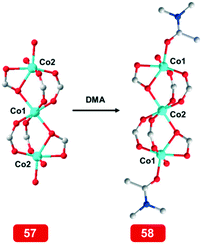 |
| | Fig. 21 Solvent-induced SCSC transformation between 57 and 58. Reproduced with permission from ref. 38. Copyright 2019, Elsevier. | |
A series of 2D CuII CPs, [Cu(HT4)(H2O)]·MeOH (59), [Cu(HT4)(DMSO)]·solvent (solvent = MeOH and DMSO) (60), [Cu(HT4)(MeOH)]·solvent (solvent = MeOH and DMSO) (61) and [Cu(HT4)(MeOH)]·MeOH (62, H3T4 = tris-[4-(1H-tetrazol-5-yl)phenyl]amine) show unique reversible cascades of SCSC transformation with the replacement of the solvent molecules (Fig. 22).3959 crystallizes in the orthorhombic space group Pmma. Each CuII is octahedrally coordinated by four N atoms from HT42− and two μ2-H2O oxygen atoms. When primary dark green 59 is immersed in DMSO or MeOH, it converts into bright green 60 or dark green 62 without a significant change in the backbone and CN of the Cu centre (pathway II) except that the coordinated μ2-H2O in 59 was replaced by μ2-DMSO in 60 or μ2-MeOH in 62. This transformation can be reversed immediately by soaking 60/62 in the mother liquid, regenerating 59. However, when 60 is exposed to air, the primary dark green 61 is obtained, and 61 can change back to 60 when it is put into DMSO. Although there is no remarkable difference between the backbones of 61 and 62, these CPs crystallize in different space groups with Cmcm for 61 and Pmma for 62. The gas adsorption measurements show that 59 has a certain ability for N2 and CO2 adsorption, while 61 and 62 show selective adsorption of CO2 over N2.
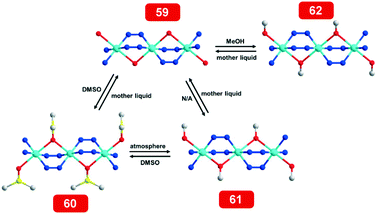 |
| | Fig. 22 The reversible SCSC transformations with the replacement of the solvent molecules of 59–61. Reproduced with permission from ref. 39. Copyright 2012, the Royal Society of Chemistry. | |
A multiple SCSC transformation of 2D CPs, [Co3(H2O)4(TCPSB)2(bipy)(DMF)2]·2.5DMF (63) → [Co3(H2O)4(TCPSB)2(bipy)(MeCN)2]·2MeCN (64) → [Co3(H2O)6(TCPSB)2(bipy)]·8H2O (65) → 63 (TCPSB = 1,3,5-tri(4′-carboxyphenylsulphonyl)benzene, bipy = 4,4′-bipyridine) was reported by Xu et al. (Fig. 23).4963 crystallizes in the space group P![[1 with combining macron]](https://www.rsc.org/images/entities/char_0031_0304.gif) and contains centrosymmetric, line trinuclear CoII aqua clusters (Co1–O–Co2–O–Co1). Both hexa-coordinated CoII centres adopt an octahedral geometry, Co1 is bound by two carboxylate O atoms from TCPSB, two water O molecules, one DMF oxygen atom, and one bipy N atom. Co2 is bound by four carboxylate O atoms from TCPSB and two μ2-H2O oxygen atoms. Immersion of 63 in MeCN solution results in 64 which can further transform into a new phase 65 after being exposed to air. During this transformation, the coordinated DMF/MeCN molecules are replaced by MeCN/H2O with no change in CN of the Co centres (pathway II). Lastly, CP 65 can convert into 63 upon immersing in DMF.
and contains centrosymmetric, line trinuclear CoII aqua clusters (Co1–O–Co2–O–Co1). Both hexa-coordinated CoII centres adopt an octahedral geometry, Co1 is bound by two carboxylate O atoms from TCPSB, two water O molecules, one DMF oxygen atom, and one bipy N atom. Co2 is bound by four carboxylate O atoms from TCPSB and two μ2-H2O oxygen atoms. Immersion of 63 in MeCN solution results in 64 which can further transform into a new phase 65 after being exposed to air. During this transformation, the coordinated DMF/MeCN molecules are replaced by MeCN/H2O with no change in CN of the Co centres (pathway II). Lastly, CP 65 can convert into 63 upon immersing in DMF.
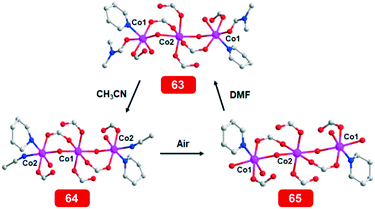 |
| | Fig. 23 Multiple SCSC transformations of 63, 64 and 65. Reproduced with permission from ref. 49. Copyright 2011, American Chemical Society. | |
One 2D {[Cd(azim)2(DMF)2]·(ClO4)2·2DMF}n (66, azim = bis(4-imidazol-1-yl-phenyl)diazene) can convert to {[Cd(azim)2(DEF)2]·(ClO4)2·2DEF}n (67) upon soaking in DEF in SCSC fashion (Fig. 24).59 CPs 66 and 67 both crystallize in the triclinic space group P![[1 with combining macron]](https://www.rsc.org/images/entities/char_0031_0304.gif) . In 66, each CdII ion is a distorted octahedron coordinated with four equatorial N of azim and two axial DMF oxygen atoms. In 67, all lattice and coordinated DMF molecules are replaced by an equal number of DEF molecules without a change in structure and CN of CdII (pathway II), leading to a CdO2N4 octahedral coordination geometry.
. In 66, each CdII ion is a distorted octahedron coordinated with four equatorial N of azim and two axial DMF oxygen atoms. In 67, all lattice and coordinated DMF molecules are replaced by an equal number of DEF molecules without a change in structure and CN of CdII (pathway II), leading to a CdO2N4 octahedral coordination geometry.
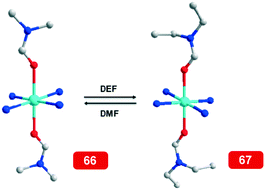 |
| | Fig. 24 The reversible SCSC transformations between 66 and 67. Reproduced with permission from ref. 59. Copyright 2011, American Chemical Society. | |
Natarajan et al. reported a 3D [Mn3(SDBA)3(DMA)2(MeOH)]·DMA (68, H2SDBA = 4,4′-sulfonyldibenzoic acid), in which the coordinated MeOH molecule can be reversibly exchanged by a variety of other similar solvents via a solvent-mediated SCSC transformation, giving a series of complexes [Mn3(SDBA)3(DMA)2(Xsolvent)]·DMA (Xsolvent = EtOH in 69, MeCN in 70, H2O in 71, and ethylene glycol in 72) (Fig. 25).60 All these CPs crystallize in the monoclinic space group P21/n. In 68, there are three crystallographically independent MnII ions (Mn1, Mn2 and Mn3). Both Mn1 and Mn2 exhibit a distorted octahedral geometry formed by six carboxylate O atoms of SDBA2− for Mn1, and four carboxylate O atoms, one DMA oxygen atom and one MeOH oxygen atom for Mn2. The penta-coordinated Mn3 is bonded by the carboxylate oxygens and one DMA oxygen, showing a distorted square pyramidal geometry. After soaking in a mixture of DMA and various solvents, the resultant crystals proved unequivocally the substitution of the coordinated MeOH with the other Xsolvent molecules on the Mn2 centre. The structurally similar 69–72 are entirely consistent with 68, and the only differences are the coordinated solvent molecules with minor changes in the CG of Mn2 (pathway II). Magnetic studies on the parent CP 68 indicate only antiferromagnetic behaviour.
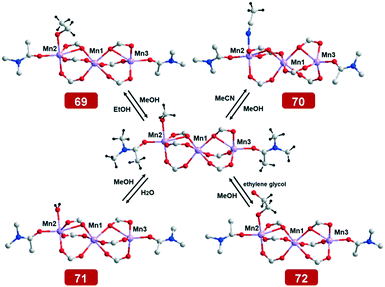 |
| | Fig. 25 SCSC transformations that resulted in the exchange of terminal solvent ligands. Reproduced with permission from ref. 60. Copyright 2015, American Chemical Society. | |
They also reported a similar work on 3D CoII CPs: exchange of coordinated solvents in the 3D [Co3(C14H8O6S)3(DMA)2(MeOH)]·DMA (73) results in a series of CPs, [Co3(C14H8O6S)3(DMA)2(Xsolvent)]·DMA (Xsolvent = EtOH in 74, MeCN in 75, H2O in 76, and ethylene glycol in 77), in SCSC fashion with no noticeable change in morphology (Fig. 26).4373 crystallizes in the monoclinic space group P21/n, and there are three crystallographically independent CoII ions. Co1 shows a distorted octahedral geometry constituted by six carboxylate oxygen atoms from SDBA2− ligands. Co2 also shows a distorted octahedral arrangement which is formed by four carboxylate oxygen atoms, one DMA molecule, and one MeOH molecule. Co3 exhibits a tetrahedral environment formed by three carboxylate oxygen atoms and one DMA molecule. Both MeOH and DMA are terminal and hang freely from the metal centres. During this transformation, there are only minor variations around the coordination sphere of the CoII ions. The MeOH molecules connected to Co2 can be exchanged by Xsolvent molecules, and Co2 exhibits a distorted octahedral arrangement in 74, 75 and 77, and a distorted trigonal bipyramidal environment in 76 without a change in CN of Co2 (pathway II). Magnetic studies on 73 indicate antiferromagnetic interactions between the central metal atoms.
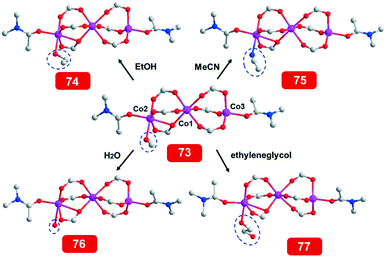 |
| | Fig. 26 SCSC transformations that resulted in the exchange of terminal MeOH solvent by EtOH, MeCN, H2O and ethyleneglycol. Reproduced from ref. 43. Copyright 2014, Wiley-VCH. | |
Xu et al. reported that 3D Zn2(L)0.5(DMSO)(H2O)·xSolvent (78, H8L = 5,5′-(2,2-bis((3,5-dicarboxyphenoxy)methyl)propane-1,3-diyl)bis(oxy)diidophthalic acid) undergoes coordinated solvent-substituted SCSC transformations to afford three new CPs, Zn2(L)0.5(DMF)(H2O) (79), Zn2(L)0.5(DMA)(H2O)·xSolvent (80), and Zn2(L)0.5(EtOH)(H2O)·xSolvent (81) (Fig. 27).61 These CPs have a similar framework. CP 78 crystallizes in the space group Pbcm, and there are two types of Zn2 clusters which are similarly coordinated by DMSO or H2O molecules as axial groups and four carboxylates from four bridging L ligands in a classical paddle wheel mode. 78 is solvothermally treated with respective solvents to accordingly afford solvent-substituted single crystals, in which the terminally coordinated DMSO molecules are replaced by new solvent molecules (DMF, DMA and EtOH) without a change in CN of ZnII ions. Significantly, 81 can further transform into Zn2(L)0.5(H2O)2·xSolvent (82) upon exposure to air. CP 82 crystallizes in a different space group of P4/ncc. In addition, one Zn2 cluster in a paddle wheel environment coordinated by two H2O molecules at axial positions and four carboxylate groups from L ligands has been observed. Also, Yuan et al. reported a similar work about solvent exchange (H2O ⇌ DMF) occurring in the classical paddle wheel Cu2 cluster.62
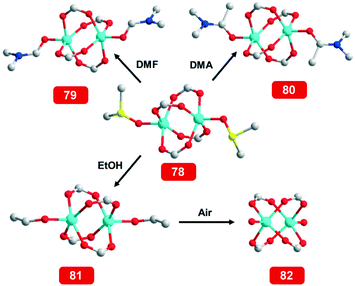 |
| | Fig. 27 The solvent-induced SCSC transformations of 78 → 79, 78 → 80 and 78 → 81 → 82. Reproduced from ref. 61. Copyright 2012, American Chemical Society. | |
Bharadwaj et al. reported a porous 3D {[Mn(L)(H2O)]·(H2O)1.5·(DMF)}n (83, H2L = 5-((pyridin-4-ylmethyl)amino)isophthalic acid) containing a water molecule coordinated at the apical position of each distorted octahedral MnII centre (Fig. 28).4483 crystallizes in the monoclinic space group C2/c, and each MnII ion is surrounded by four equatorial carboxylate oxygen atoms from L ligands, one water molecule and one pyridyl group at the axial positions. The coordinated water molecule can be substituted by nitrile guest molecules (MeCN, acrylonitrile ACN, allylnitrile AN and crotononitrile CTN), giving CPs {[Mn(L)(MeCN)]·(MeCN)1.5}n (84), {[Mn(L)(ACN)]·(ACN)}n (85), {[Mn(L)(AN)]·(AN)}n (86) and {[Mn(L)(CTN)]·(CTN)}n (87), respectively. Moreover, CPs 84–87 were dipped in DMF at room temperature and regenerated the mother crystal 83 in each case. Also, CPs 84–87 can be interconverted among one another by dipping them in appropriate nitrile guests in SCSC fashion. During the process of structural transformation, there is no change in the CN of the MnII ion (pathway II).
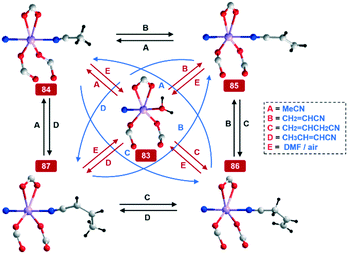 |
| | Fig. 28 The solvent-induced SCSC transformations of CPs 83–87. Reproduced from ref. 44. Copyright 2009, American Chemical Society. | |
LnIII MOFs (LnMOFs) with polycarboxylate ligands seem to be excellent candidates for studying SCSC transformations because they possess high stability in air and weakly bound solvent ligands that could be easily removed without collapse of their frameworks.63 For example, Tasiopoulos et al. reported that 3D [Nd2(CIP)2(DMF)2.8(H2O)1.2] (88, H3CIP = 5-(4-carboxybenzylideneamino)isophthalic acid) exhibits a unique capability to undergo a plethora of SCSC transformations involving the replacement of coordinating solvent molecules by terminally ligating solvents or organic ligands.4088 contains the dinuclear [Nd2(COO)6(DMF)2.8(H2O)1.2] SBU. Each NdIII ion is coordinated by nine oxygen atoms from five carboxylate groups and two DMF molecules. Solvent exchange experiments of 88 are performed at 50 or 100 °C and the coordinated solvent molecules are replaced by MeOH (89), EtOH (90), acetone (91), THF (92), and py (93) (Fig. 29). Even though the structures of 88–93 are similar and the metal CNs are the same, the metal CG changes from a distorted three-capped triangular prism (88) to a distorted single-capped square antiprism (89–93). CPs 89, 92 and 93 contain one X solvent (X = MeOH, THF, py) and one H2O terminal ligand connected to each NdIII ion, and for the exchanged solvent EtOH or acetone, the DMF molecules are all substituted by EtOH (90) or acetone (91). Although all other exchanged CPs and the pristine 88 crystallize in the monoclinic space group C2/c, 93 displays a lower symmetry (triclinic P![[1 with combining macron]](https://www.rsc.org/images/entities/char_0031_0304.gif) ).
).
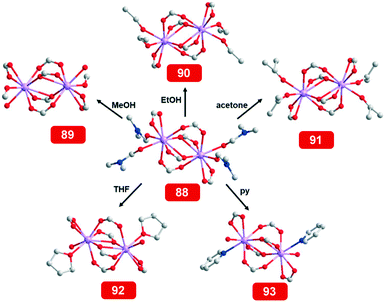 |
| | Fig. 29 SCSC transformations that resulted in the exchange of terminal solvent ligands of 88 by MeOH, EtOH, acetone, THF and py. Reproduced from ref. 40. Copyright 2012, American Chemical Society. | |
Next, they also reported a series of isostructural 3D LnMOFs, [Ln2(CIP)2(DMF)4−x(H2O)x] (LnIII = LaIII, CeIII, PrIII, SmIII, EuIII, GdIII, TbIII, DyIII, HoIII; x = 0–2).41 Among them, [Ce2(CIP)2(DMF)4] (94) undergoes solvent-exchange reactions with MeOH or acetone at 50 °C, giving [Ce2(CIP)2(MeOH)4] (95) or [Ce2(CIP)2(Acetone)2(H2O)2] (96) (Fig. 30). CP 94 crystallizes in the monoclinic space group C2/c and contains the dinuclear [Ce2(COO)6(DMF)4] SBU. Each CeIII ion is nine-coordinated by seven oxygen atoms from five carboxylate groups and two DMF oxygen atoms. 95 or 96 adopts a similar metal coordination environment except that the two coordinated DMF molecules are replaced by two MeOH molecules in 95 or one acetone and one water molecule in 96. In addition, they also reported some other examples showing similar SCSC transformations involving the replacement of coordinating solvent molecules by terminally ligating organic ligands.63
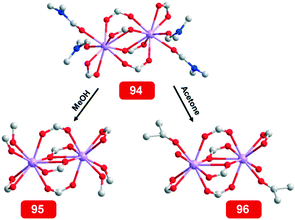 |
| | Fig. 30 SCSC transformations involving the exchange of terminal solvent ligands of 94 by MeOH and acetone. Reproduced from ref. 41. Copyright 2012, American Chemical Society. | |
The solvents can act as a structure-directing agent in the SCSC transformation, in which the solvents play an important role in the formation of CPs, but not a structural component. A porous 3D [Cu3L2(μ3-OH)2(μ2-H2O)]·2DMA (97, mother crystal, H2L = 2,2′-dinitrobiphenyl-4,4′-dicarboxylic acid) shows irreversible SCSC transformations when immersed at RT in acetone, 2-propanol and 2-butanol, respectively, producing quantitatively three daughter crystals, [Cu3L2(μ3-OH)2]·2S (S = acetone, 98; 2-propanol, 98A; 2-butanol, 98B) (Fig. 31).64 All the CPs crystallize in the monoclinic space group P21/c, and three independent CuII ions exist in the asymmetric unit. Both Cu1 and Cu2 are hexa-coordinated by three carboxylate O atoms, one water oxygen atom (O1W) and two μ3-OH− ions (O1 and O6), showing elongated octahedral geometries, while penta-coordinated Cu3 shows a trigonal bipyramid geometry consisting of three equatorial carboxyl oxygen atoms and two axial μ3-OH− ions. Isostructural 98 and 98B adopt the same space group of 97 and differ mainly in guest molecules. Compared to the coordination environments of Cu1(Cu2), one bridging carboxylate in 97 shifts and is converted to a chelating carboxylate group and replaces the coordinated water molecules in 97. In 98, both Cu1 and Cu2 adopt elongated octahedral geometries, while Cu3 is located at a trigonal bipyramid geometry. CP 97 shows excellent separation selectivity (128) of CO2/N2 at RT.
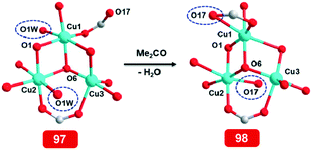 |
| | Fig. 31 The SCSC transformation between 97 and 98. Reproduced with permission from ref. 64. Copyright 2014, the Royal Society of Chemistry. | |
Li et al. reported a solvent-induced SCSC transformation between three InIII CPs: [In3(TTTA)2(OH)3(H2O)]·(DMA)3 (99, TTTA3− = 2E, 2′E,2′′E)-3,3′,3′′-(2,4,6-trimethylbenzene-1,3,5-triyl)-triacrylate), [In3(TTTA)2(CH3O)3] (100) and [In3(TTTA)2(OH)3] (101).65 These CPs are isostructural with rod-shaped SBUs and crystallize in the monoclinic system, space group P21/c. There are four crystallographically independent InIII ions in 99–101, and the four InIII ions are all coordinated with six O atoms in a distorted octahedral geometry (Fig. 32). In 99, In1, In3 and In4 are coordinated by equatorial four carboxylate O atoms and two axial μ2-OH− groups, while In2 is coordinated by three carboxylate O atoms and one hydroxyl O atom at the equatorial positions and one hydroxyl O atom and one H2O at the apical positions. The metal coordination environments are changed after SCSC transformation. For 99 → 100, the coordinated OH− groups in In1, In3 and In4 are replaced by MeO− groups, and the coordinated H2O in In2 is lost and the bridge carboxylate group coordinated to In3 shifts and coordinates to In2. The InIII ions in 101 have a similar coordination environment except that the MeO− groups are replaced by OH− groups. Gas sorption studies reveal that both 100 and 101 have good separation performances toward C2H2 over CO2 and C2H2 over CH4.
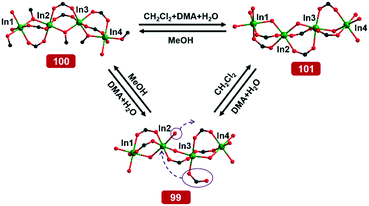 |
| | Fig. 32 The SCSC transformation between 99 and 101. Reproduced with permission from ref. 65. Copyright 2017, American Chemical Society. | |
3.2 SCSC transformation with change in the framework
Structural assembly and reversible transformation between a metallogrid Dy4 CP [Dy4(bzhdep-2H)4(NO3)4(H2O)4]·6MeOH·6H2O (103) and its fragment Dy2 CP [Dy2(bzhdep-2H)(NO3)4(DMF)4] (102) are established in the different solvent media (DMF and H2O) (Fig. 33).66 Note that MeOH acts as a structure-directing agent in the structural transformation 102 → 103. CP 102 crystallizes in the monoclinic space group P21/c, and each nine-coordinated DyIII ion is bonded to one fully deprotonated ligand as a N2O pocket, two chelating nitrates and two DMF molecules, giving a N2O7 irregular geometry “muffin”. CP 103 crystallizes in the orthorhombic space group Fddd; four coplanar DyIII ions are linked together to form a tetra-nuclear metallogrid. Each DyIII ion is nine-coordinated by two sets of N2O pockets, one chelating nitrate, and one water molecule to form a single-capped square antiprism. The zero-field magnetization relaxation was slowed for dysprosium metallogrid 103 with a relaxation barrier of Ueff = 61.3 K compared to 102.
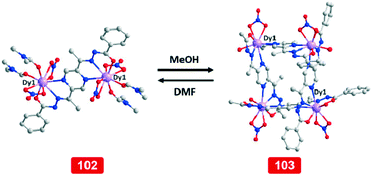 |
| | Fig. 33 The reversible transformation between 102 and 103. Reproduced from ref. 66. Copyright 2016, American Chemical Society. | |
The reversible SCSC transformation between two isostructural 1D CPs {[Ln(OAc)2(H2O)(OBPT)]·3H2O}n (HOBPT = 4,6-bis(2-pyridyl)-1,3,5-triazin-2-ol, Ln = EuIII, 104; TbIII, 106) and two discrete CPs [Ln(OAc)2(DMF)2(OBPT)] (Ln = EuIII, 105; TbIII, 107) is achieved by immersing the crystalline samples 104/106 in the corresponding solvent (H2O or DMF) or by exposing them to the solvent vapor (Fig. 34).67 CPs 104 and 105 crystallize in the P![[1 with combining macron]](https://www.rsc.org/images/entities/char_0031_0304.gif) and C2/c space group, respectively. SC-XRD reveals that the CGs of EuIII in 104 and 105 are similar and can be described as a distorted tricapped trigonal prism with six oxygen atoms and three N atoms. The difference between them is that one water molecule and one oxygen atom from an OBPT ligand complete the coordination sphere in 104, whereas two DMF molecules complete the coordination sphere in 105. Luminescence measurement revealed that the photoluminescence intensity of 105 is stronger than that of 104.
and C2/c space group, respectively. SC-XRD reveals that the CGs of EuIII in 104 and 105 are similar and can be described as a distorted tricapped trigonal prism with six oxygen atoms and three N atoms. The difference between them is that one water molecule and one oxygen atom from an OBPT ligand complete the coordination sphere in 104, whereas two DMF molecules complete the coordination sphere in 105. Luminescence measurement revealed that the photoluminescence intensity of 105 is stronger than that of 104.
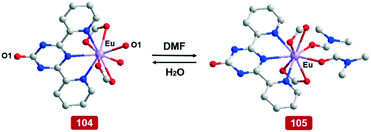 |
| | Fig. 34 The reversible SCSC transformation between 104 and 105. Reproduced from ref. 67. Copyright 2013, American Chemical Society. | |
Structural transformation between 1D ring-like chain [Cu1.5(HL)(py)2(H2O)]n·nH2O (108, H4L = 5,5′-((1,4-phenylenebis(methylene))bis(oxy))diisophthalic acid) and 2D hexagon layer [Cu2(L)(py)4(H2O)4]n·nH2O (109) has been reported by He and co-workers (Fig. 35).68 Experimental results show that 108 is an intermediate phase during the formation of 109, and these two CPs can be isolated successfully by controlling the reaction time. CPs 108 and 109 crystallize in the triclinic and monoclinic space group P![[1 with combining macron]](https://www.rsc.org/images/entities/char_0031_0304.gif) and C2/m, respectively. 108 has two types of Cu centres, whereas the transformed product 109 has one type of Cu centre. In 108, penta-coordinated Cu1 shows a distorted square pyramidal coordination geometry completed by three carboxyl atoms from HL3− and two py N atoms. Tetra-coordinated Cu2 exhibits a square planar geometry completed by two carboxyl O atoms and two water O atoms. In 109, the hexa-coordinated octahedral CuII ion is surrounded by two carboxyl O atoms, two water O atoms, and two py N atoms. Such a conversion occurred with a change in metal CN and CG (pathway I). Furthermore, the size effect and π-π interactions between the aromatic rings in the 2D layers resulted in 109 having high response and good selectivity to benzene vapor.
and C2/m, respectively. 108 has two types of Cu centres, whereas the transformed product 109 has one type of Cu centre. In 108, penta-coordinated Cu1 shows a distorted square pyramidal coordination geometry completed by three carboxyl atoms from HL3− and two py N atoms. Tetra-coordinated Cu2 exhibits a square planar geometry completed by two carboxyl O atoms and two water O atoms. In 109, the hexa-coordinated octahedral CuII ion is surrounded by two carboxyl O atoms, two water O atoms, and two py N atoms. Such a conversion occurred with a change in metal CN and CG (pathway I). Furthermore, the size effect and π-π interactions between the aromatic rings in the 2D layers resulted in 109 having high response and good selectivity to benzene vapor.
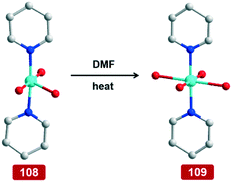 |
| | Fig. 35 The SCSC transformation between 108 and 109. Reproduced from ref. 68. Copyright 2020, Elsevier. | |
A 2D [Mn3(ip)3(bipy)2]n·2nH2O (110, H2ip = isophthalic acid, bipy = 2,2′-bipyridine) and its dehydrated material show irreversible water adsorption at room temperature (Fig. 36).69 Simply soaking either 110 or its dehydrated material in water results in the formation of 1D [Mn(ip)(bipy)(H2O)2]n·nH2O (111). CPs 110 and 111 crystallize in the triclinic and monoclinic space groups P![[1 with combining macron]](https://www.rsc.org/images/entities/char_0031_0304.gif) and P21/c, respectively. 110 possesses two types of symmetry-independent, but very similar linear trimetallic clusters with an inversion on hexa-coordinated Mn2 or Mn4 bridged by six carboxylate oxygens from ip ligands. The penta-coordinated Mn1 or Mn3 is bonded to three carboxylate oxygens from ip ligands and two N atoms from bipy ligands, resulting in a distorted square pyramidal coordination and a highly distorted trigonal bipyramidal coordination on Mn1 and Mn3, respectively. Different from the four crystallographically independent MnII ions in 110, in 111, there is only one independent MnII in the asymmetric unit, and each MnII displays a distorted MnN2O4 octahedral environment coordinated by the two carboxylate O atoms, two N atoms from a bipy ligand and two terminal H2O molecule. The metal coordination environment has been changed (pathway I).
and P21/c, respectively. 110 possesses two types of symmetry-independent, but very similar linear trimetallic clusters with an inversion on hexa-coordinated Mn2 or Mn4 bridged by six carboxylate oxygens from ip ligands. The penta-coordinated Mn1 or Mn3 is bonded to three carboxylate oxygens from ip ligands and two N atoms from bipy ligands, resulting in a distorted square pyramidal coordination and a highly distorted trigonal bipyramidal coordination on Mn1 and Mn3, respectively. Different from the four crystallographically independent MnII ions in 110, in 111, there is only one independent MnII in the asymmetric unit, and each MnII displays a distorted MnN2O4 octahedral environment coordinated by the two carboxylate O atoms, two N atoms from a bipy ligand and two terminal H2O molecule. The metal coordination environment has been changed (pathway I).
 |
| | Fig. 36 Coordination environments of Mn ions in 110 and 111. Reproduced from ref. 69. Copyright 2010, the Royal Society of Chemistry. | |
A 2D [(CH3)2NH2]2[(Ca4O)L4(H2O)4]·6DMF (112, L = 9,9′-spirobi[9H-fluorene]-2,2′-dicarcoxylic acid) can undergo a solvent-induced SCSC transformation to 113 in water and 114 in MeOH (Fig. 37).70112 shows a 2D layer wherein the square-planar Ca4O clusters are linked by L ligands. In 112, CaII ion takes a distorted octa-coordinated geometry with eight O atoms, one of which comes from the terminal H2O molecule. During this transformation process, the Ca–O of the Ca4O cluster starts to break, and then the CaII ions in one Ca4O cluster move away from each other and get close to the CaII ions in the neighboring Ca4O cluster with the formation of new Ca–O bonds. Thus, different from 112, in 114, the CaII ion is hepta-coordinated by four O atoms from three L ligands and three O atoms from MeOH with a distorted pentagonal bipyramidal geometry. 113 exhibits a similar structure to 114 except that the MeOH molecules are replaced by H2O.
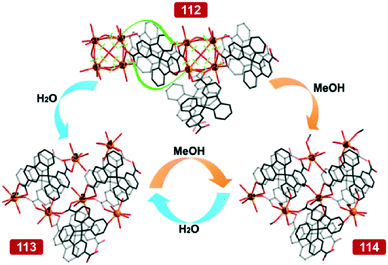 |
| | Fig. 37 The SCSC transformations for structural interconversions among 112, 113 and 114. Reprinted with permission from ref. 70. Copyright 2017, the Royal Society of Chemistry. | |
One 2D CuII CP, {[Cu(tatrz)2(NO3)2]·(MeOH)·4H2O}n (115, tatrz = 1-(9-(1H-1,2,4-triazol-1-yl)anthracen-10-yl)-1H-1,2,4-triazole), is shown to undergo SCSC transformation: 115 → {[Cu(tatrz)2(H2O)2]·(ClO4)2·4MeOH}n (116) ⇌ {[Cu(tatrz)2(DMF)2]·(ClO4)2·4H2O}n (117) (Fig. 38).71 SC-XRD reveals that 115 crystallizes in the triclinic space group P![[1 with combining macron]](https://www.rsc.org/images/entities/char_0031_0304.gif) , and each CuII lies in a crystallographic inversion centre. The central CuII ion is hexa-coordinated by two axial nitrate oxygen atoms and four equatorial N atoms from tatrz ligands, showing a slightly distorted octahedron. 115 is immersed in the H2O/MeOH of sodium perchlorate monohydrate and convert to 116 (monoclinic; space group P21/c), which further transforms to 117 (monoclinic; space group P21/c) by immersing 116 in DMF and 117 undergoes a solvent–ligand substitution reaction to yield 116. In isostructural 116 and 117, the central CuII ion lies in the inversion position, and two axial oxygen atoms are from two terminal coordinated H2O (116) /DMF (117), whereas in 115, two axial N atoms are from two NO3− anions (pathway II).
, and each CuII lies in a crystallographic inversion centre. The central CuII ion is hexa-coordinated by two axial nitrate oxygen atoms and four equatorial N atoms from tatrz ligands, showing a slightly distorted octahedron. 115 is immersed in the H2O/MeOH of sodium perchlorate monohydrate and convert to 116 (monoclinic; space group P21/c), which further transforms to 117 (monoclinic; space group P21/c) by immersing 116 in DMF and 117 undergoes a solvent–ligand substitution reaction to yield 116. In isostructural 116 and 117, the central CuII ion lies in the inversion position, and two axial oxygen atoms are from two terminal coordinated H2O (116) /DMF (117), whereas in 115, two axial N atoms are from two NO3− anions (pathway II).
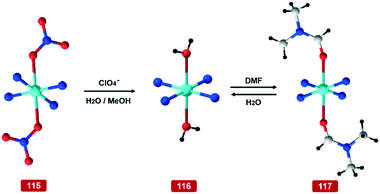 |
| | Fig. 38 Coordination environments of CuII in 115, 116 and 117. Reproduced from ref. 71. Copyright 2014, American Chemical Society. | |
Lin et al. reported a solvent-induced SCSC transformation of a 2D [Zn2L(DMF)4]·2DMF·4H2O (118) to a 3D [Zn2L(H2O)2]·xSolvent (119) (Fig. 39).47118 crystallizes in the orthorhombic space group Pnn2. Each ZnII ion is chelated to two carboxylate groups and coordinated to two DMF molecules, resulting in a distorted octahedral coordination geometry. When 118 is soaked in CH2Cl2 at room temperature, it transforms into 119 (chiral orthorhombic; space group P21212). The solvent CH2Cl2 acts as a structure-directing agent in such a structural transformation. The most significant change from 118 to 119 is the dimerization of Zn centres in different layers of 118 to generate a 3D porous framework. In 119, both Zn1 and Zn2 centres adopt a five-coordinated distorted trigonal bipyramidal geometry. Zn1 is surrounded by carboxylate groups, and Zn2 is bonded to three carboxylate oxygens and two H2O molecules. The topological transformation from 2D networks to a 3D framework significantly enhanced the framework stability and increased the surface area and hydrogen uptake capacity.
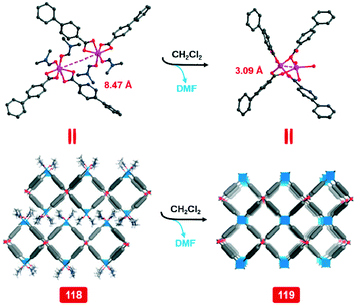 |
| | Fig. 39 The SCSC transformation of 2D layers of 118 to a 3D 119. Reproduced with permission from ref. 47. Copyright 2012, the Royal Society of Chemistry. | |
A [Co6(μ3-OH)4(datrz)2]6+ ribbon-based 3D {[Co3(MeOH)(μ3-OH)2(datrz)(sip)]·2.25H2O}n (120, Hdatrz = 3,5-diamino-1,2,4-triazole, sip3− = 3,5-dicarboxybenzenesulfonate) exhibited a reversible SCSC transformation by solvent exchange to generate a 2D CP with a similar [Co6(μ3-OH)4(datrz)2]6+ ribbon to 120, {[Co3(H2O)3(μ3-OH)2(datrz)(sip)]·2.125H2O}n (121) (Fig. 40).72 In 120, there are three crystallographically independent CoII ions, in which there are two different coordination spheres with distorted octahedrons for the Co1 and Co2 sites and an irregular tetrahedron for the Co3. Co1 is bonded to one MeOH oxygen atom, two μ3-OH groups, two carboxylate oxygen atoms and one N atom from the datrz− ligand. Co2 is in an N2O4 donor set fulfilled by three μ3-OH groups, one bidentate bridging carboxylate O atom of a sip3− ligand and two N donors from triazolyl and exocyclic amino groups of datrz− ligands. In contrast, the tetrahedral Co3 is surrounded by one triazolyl N atom from a datrz− anion and one μ3-OH, a monodentate SO42− and the bidentate bridging carboxylate group of two sip3− ligands. 121 crystallizes in the monoclinic P21/c space group. Upon hydration, the terminal MeOH, one μ3-OH group and one carboxylate group around the octahedral Co1 of 120 are replaced by three H2O in 121. The tetrahedral Co3 becomes penta-coordinated in a square pyramidal geometry in 121, which is surrounded by one heterocyclic N atom of one datrz−, a pair of μ3-OH groups and two carboxylate O donors of sip3− ligands. Additionally, the binding sulfonate group of sip3− in 120 is free in 121, which essentially decreases the dimensionality of 121. A reversible transformation from a blue metamagnetic 120 to a pink antiferromagnetic 121 has been readily obtained by solvent exchange.
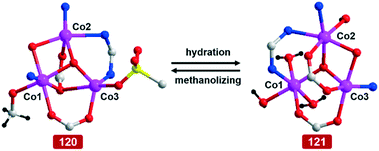 |
| | Fig. 40 The appearance and local coordination environments of the CoII ions in 120 and 121. Reproduced from ref. 72. Copyright 2012, the Royal Society of Chemistry. | |
Bharadwaj et al. reported reversible solvent-induced SCSC transformations between one mother crystal 3D {[Gd2(L)3(DMF)2(H2O)2]·(DMF)2·(H2O)5.5}n (122, L = 5-[(anthracen-9-ylmethyl)-amino]-isophthalic acid) and three daughter products {[Gd2(L)3(H2O)4]·(DMF)4·(H2O)1.5}n (123), {[Gd2(L)3(DMF)2(H2O)]·(DMF)2·(DCM)2·(H2O)5}n (124), and [Gd(L)2(DEF)]n (125) (Fig. 41).27 The solvent molecules, DCM and benzene, act as structure-directing agents in such a structural transformation. CP 122 crystallizes in the triclinic space group P![[1 with combining macron]](https://www.rsc.org/images/entities/char_0031_0304.gif) , and two crystallographically independent GdIII ions exist in the asymmetric unit. Both Gd1 and Gd2 show nine coordination with two chelated carboxylates, two chelated-bridged carboxylates, one DMF oxygen atom, and one water oxygen atom, giving an overall distorted monocapped square antiprismatic coordination geometry. When 122 is immersed in benzene at room temperature for 2 days, it forms 123 (monoclinic; group space P21/c). Compared to the coordination environment of GdIII in 122, the coordinated DMF molecules were all replaced by the H2O molecules, and three chelating/chelating-bridging carboxylates shift and are converted to a bridging carboxylate group in 123. When 122 is immersed in DCM for 2 days, it transformed into 124 (triclinic; space group P
, and two crystallographically independent GdIII ions exist in the asymmetric unit. Both Gd1 and Gd2 show nine coordination with two chelated carboxylates, two chelated-bridged carboxylates, one DMF oxygen atom, and one water oxygen atom, giving an overall distorted monocapped square antiprismatic coordination geometry. When 122 is immersed in benzene at room temperature for 2 days, it forms 123 (monoclinic; group space P21/c). Compared to the coordination environment of GdIII in 122, the coordinated DMF molecules were all replaced by the H2O molecules, and three chelating/chelating-bridging carboxylates shift and are converted to a bridging carboxylate group in 123. When 122 is immersed in DCM for 2 days, it transformed into 124 (triclinic; space group P![[1 with combining macron]](https://www.rsc.org/images/entities/char_0031_0304.gif) ). In 124, the CN of Gd1 and Gd2 remain the same as those of 122, but one of the chelating carboxylates in 122 undergoes a “carboxylate shift” and is transformed into the chelating-bridging carboxylate mode. Gd1 is bonded to seven O atoms from L, one DMF oxygen atom, and one water oxygen atom, while Gd2 is coordinated to eight oxygen atoms from L and one DMF oxygen atom. When 122 is dipped in DEF for 2 days, it forms 125 (monoclinic; space group P21/c), and 125 can also transform to 122 when it is immersed in a mixture of DMF and H2O. The coordination environment of the GdIII ion in 125 is different from that of 122 and is completed by six O atoms of L and one DEF oxygen atom, showing a distorted GdO7 mono-capped trigonal prismatic geometry.
). In 124, the CN of Gd1 and Gd2 remain the same as those of 122, but one of the chelating carboxylates in 122 undergoes a “carboxylate shift” and is transformed into the chelating-bridging carboxylate mode. Gd1 is bonded to seven O atoms from L, one DMF oxygen atom, and one water oxygen atom, while Gd2 is coordinated to eight oxygen atoms from L and one DMF oxygen atom. When 122 is dipped in DEF for 2 days, it forms 125 (monoclinic; space group P21/c), and 125 can also transform to 122 when it is immersed in a mixture of DMF and H2O. The coordination environment of the GdIII ion in 125 is different from that of 122 and is completed by six O atoms of L and one DEF oxygen atom, showing a distorted GdO7 mono-capped trigonal prismatic geometry.
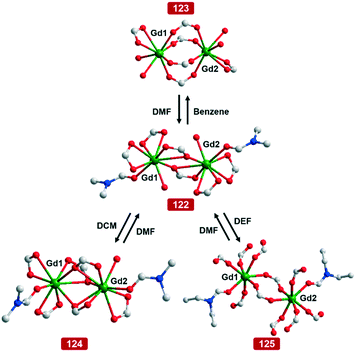 |
| | Fig. 41 The reversible SCSC transformations in different polar solvents. Reproduced from ref. 27. Copyright 2014, American Chemical Society. | |
Qian et al. reported a solvent-induced reversible SCSC transformation (Fig. 42).73 3D [Mn3(sdc)3(H2O)2]·DMF (126, H2sdc = 4,4′-stilbenedicarboxylic acid) can transform into a new phase 3D [Mn(sdc)(H2O)2] (127) induced by trace levels of H2O at room temperature. Reversibly, the transformation from 127 to 126 can be triggered by DMF upon heating beyond 100 °C. The solvent DMF acts as a structure-directing agent in such a structural transformation. The 126 featured trinuclear Mn3(RCOO)6 SBUs with one central octahedrally coordinated MnII and two terminal symmetry-equivalent hepta-coordinated MnII. But in 127, all MnII are hexa-coordinated with four carboxyl oxygen atoms from four sdc2− and two water oxygen atoms. The structures of 126 (trigonal; space group R![[3 with combining macron]](https://www.rsc.org/images/entities/char_0033_0304.gif) ) and 127 (monoclinic; space group P21/) are different. Upon stimulation by H2O, the trinuclear MnII clusters in 126 are destroyed and the lattice undergoes a rearrangement through the rotation of H2sdc and the breakage and reconstruction of Mn–O bonds, resulting in the mononuclear MnII octahedral polyhedron of 127. In addition, 127 can be developed as an excellent Pb2+ sensor in aqueous solution through the luminescence quenching effect.
) and 127 (monoclinic; space group P21/) are different. Upon stimulation by H2O, the trinuclear MnII clusters in 126 are destroyed and the lattice undergoes a rearrangement through the rotation of H2sdc and the breakage and reconstruction of Mn–O bonds, resulting in the mononuclear MnII octahedral polyhedron of 127. In addition, 127 can be developed as an excellent Pb2+ sensor in aqueous solution through the luminescence quenching effect.
 |
| | Fig. 42 The reversible SCSC transformation between 126 and 127. Reproduced from ref. 73. Copyright 2018, Wiley-VCH. | |
Zhu et al. reported a solvent-assisted structural transformation between 3D [Zn4(bptc)2(H2O)3]n (128, H4bptc = 2,2,3′,4′-biphenyltetra-carboxylic acid, pra = pyridine-2-amine) and 3D {[Zn2(bptc)(H2O)4]·(pra)]n (129) by immersing 128 in the mother liquid (Fig. 43).74 Structural analyses reveal that the cleavage of Zn–O coordination bonds induces this structural transformation, and the Zn1 centre converts from the hexa-coordinated distorted octahedron in 128 into the penta-coordinated distorted tetragonal pyramid geometry in 129 because the water molecule is a bridging ligand instead of a terminal one in 128. Accompanied by structural transformation, significant changes in properties including UV, luminescence, and fully reversible I2 uptake of 8.5 mg g−1 have also been observed.
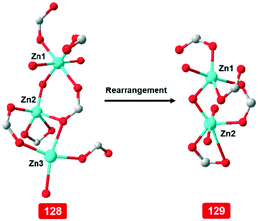 |
| | Fig. 43 The coordination environments of ZnII centres in 128 and 129. Reproduced from ref. 74. Copyright 2018, Elsevier. | |
A two-fold interpenetrated 3D {[Cu(tatrz)2(H2O)2](NO3)2·8H2O}n (130, tatrz = 1-[9-(1H-1,2,4-triazol-1-yl)anthracene-10-yl]-1H-1,2,4-triazole) can be reversible solvent-induced transformed to a noninterpenetrated 3D “cds”-type network {[Cu(tatrz)2(H2O)(DMF)](NO3)2·3H2O}n (131) (Fig. 44).75130 crystallizes in the tetragonal space group I41/a, and each hexa-coordinated CuII ion was occupied by the four N atoms form tatrz and two terminal water oxygens, exhibiting a distorted octahedral geometry. Different from 130, there are two independent CuII in 131, in which the Cu1 has the same CN as that of 130, whereas Cu2 is bonded to four N atoms from tatrz and two DMF oxygen atoms. In addition, 131 represents the first catalyst based on triazole to catalyze the aerobic homocoupling of various substituted arylboronic acids.
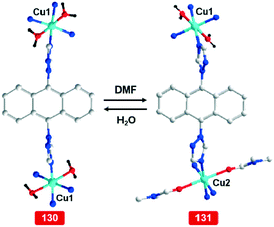 |
| | Fig. 44 The reversible SCSC transformations between 130 and 131. Reproduced from ref. 75. Copyright 2016, American Chemical Society. | |
An irreversible SCSC transformation occurred between one blue needle-shaped crystal 3D [Cu4(L)4(SO4)4]·4[Cu(H2O)6]·4SO4 (132, L = 1,4-di(1,2,4-triazole)-trans-2-butene) and a large blue block crystal 3D [Cu6(L)3(SO4)5(OH)2(H2O)6]·13H2O (133) (Fig. 45).76132 crystallizes in the orthorhombic system with the P212121 space group. Each octahedral Cu centre is hexa-coordinated by four triazole ligands which form an equatorial plane and two oxygen atoms from the sulphate ligands in the axial positions. When 132 is immersed in water at 80 °C for 48 h, 133 can be formed. 133 crystallizes in the orthorhombic system with the Pnna space group. The asymmetrical unit contains a pair of triangular trinuclear Cu cores. These trinuclear cores are alternatively bridged by three triazole fragments and a centre hydroxyl ligand. The tricopper core is capped by a sulphate anion through three of the four oxygen atoms. Each CuII is hexa-coordinated by two N atoms from L, two SO42−, one OH− and one μ3-O atom, showing a slightly distorted octahedral geometry.
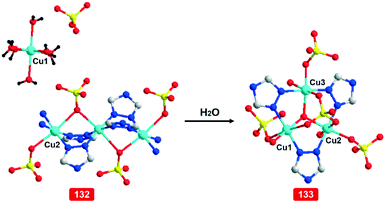 |
| | Fig. 45 The SCSC transformation between 132 and 133. Reproduced from ref. 76. Copyright 2012, the Royal Society of Chemistry. | |
4. Transformation by vapor-diffusion technique
In recent times, gas–solid-mediated SCSC transformations have received attention for their potential applications in obtaining not only vapochromic materials for detecting harmful volatile organic compounds (VOCs) but also switchable materials.77–79 In this section, we will highlight our observation on the unusual crystalline solids that do not contain pores but can facilitate the diffusion of gaseous guest species.
4.1 SCSC transformation with no change in the framework
A highly methanol-selective vapochromic response has been realized in a NiII CP [Ni(HLMe)2] (134, H2LMe = 4-methylamino-6-methyliminio-3-oxo-cyclohexa-1,4-dien-1-olate), converting into [Ni(HLMe)2(MeOH)2] (135) by the selective uptake of MeOH vapor (Fig. 46).80 When 135 is exposed to ethanol vapor, CP 134 is obtained. In 134, the Ni centre possesses a square-planar geometry composed of the HLMe- in the basal plane, whereas in 135, the Ni centre exhibits a distorted octahedron composed of two bidentate HLMe- ligands in the basal plane and two monodentate MeOH molecules at the axial sites. Such a transformation is accompanied by the change of CN (4 → 6) and CG (square-planar → distorted octahedron). Note that EtOH vapor acts as a structure-directing agent in such a structural transformation.
 |
| | Fig. 46 Reversible SCSC transformation between 134 and 135 by methanol-vapor uptake or removal in the solid state. Reproduced from ref. 80. Copyright 2017, Wiley-VCH. | |
Two tetranuclear cube-like CPs [Ni4L4(MeOH)4]·H2O (136, H2L = pyrazole-based tridentate ligand) and [Ni4L4(H2O)4]·H2O (137) can be reversibly interconverted by exposure to the respective solvent vapor, MeOH or H2O (Fig. 47).81 In both CPs, eight alternately arranged oxygen and metal atoms form a distorted [Ni4O4] cube with local S4-symmetry. The exchange of coordinated solvent molecules results in no change in CN (pathway II). All metal atoms in 136 and 137 are six-coordinated, leading to a distorted octahedral NiN2O4 coordination polyhedron. Although only small structural variations are found for the Ni–O–Ni angles of the [Ni4O4] cores of 136 and 137, these slight variations have dramatic consequences for the magnetic properties. Such structural interconversion goes along with a switching of the spin ground state from magnetism (ST = 4) to diamagnetism (ST = 0).
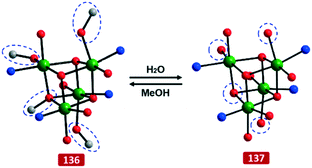 |
| | Fig. 47 The reversible structural transformation between 136 and 137. Reproduced from ref. 81. Copyright 2012, American Chemical Society. | |
Reger et al. reported a tetrameric [Cu4(Lasn)8(py)(MeOH)] (138, Lasn = L-asparagine), in which the MeOH molecule located in a chiral pocket is replaced enantioselectively when exposed to racemic ethyl lactate vapor to yield [Cu4(Lasn)8(py)((S)-ethyl lactate)] (139) in a SCSC transformation (Fig. 48).82 In 135, there are two “paddle wheel” dimeric subunits each containing four enantiopure bridging Lasn− ligands with carboxylate oxygen atoms occupying the equatorial sites in the square pyramidal geometry of the CuII ion. Two dimeric units are connected to form the tetramer by the amide carbonyl oxygens occupying the axial coordination sites of the CuII ion. One of the remaining two axial CuII sites contains a coordinated MeOH and the other is a pyridine. After SCSC transformation, 139 shows a closely similar structure to 138, and the coordinated MeOH molecule is exchanged by the (S)-ethyl lactate without a change in CN of CuII (pathway II).
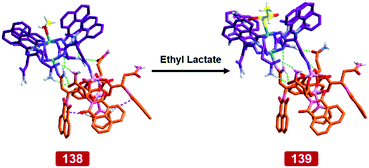 |
| | Fig. 48 The structural transformation between 138 and 139. Reproduced with permission from ref. 82. Copyright 2011, the Royal Society of Chemistry. | |
A reversible exchange of coordinated solvent molecules in a trinuclear iron CP has been observed at room temperature (Fig. 49).83 A red single crystal of [Fe3(μ3-O)(μ2-CH3COO)6(C5H5NO)2(H2O)]ClO4·3H2O (140) on exposure to MeOH vapor transforms to [Fe3(μ3-O)(μ2-CH3COO)6(C5H5NO)2(MeOH)]ClO4·3H2O (141) along with the MeOH molecule replacing a coordinated H2O molecule. 141 retransforms to 140 when exposed to atmospheric water vapor. During this transformation, no change was observed in the overall structure and color of the tri-iron cluster. Both 140 and 141 crystallize in the orthorhombic space group Pbca. The exchange of coordinated solvent is completed via the breakage of the old Fe–Osolvent bond and the formation of a new Fe–Osolvent bond without change in CN (pathway II), and the coordination geometry around the Fe is a distorted octahedral FeO6.
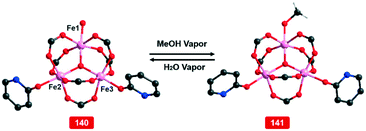 |
| | Fig. 49 Reversible structural transformation between 140 and 141. Reproduced from ref. 83. Copyright 2007, American Chemical Society. | |
4.2 SCSC transformation with change in the framework
The dinuclear FeII CP, [FeII2(L)2(MeCN)4](BF4)4·2MeCN (142, L = 4-(4-methylphenyl)-3-(3-pyridazinyl)-5-pyridyl-4H-1,2,4-triazole) is shown to undergo reversible SCSC transformations upon exposure to a variety of solvent vapors: 142 ⇌ [FeII2(L)2(EtOH)4](BF4)4 (143) → {[FeII2(L)2(H2O)4](BF4)4·2H2O·0.5EtOH}n (144) ⇌ 142 with the associated colour change, providing easy readout of the identity of the bound guest (Fig. 50).77 In addition, two ordered transient forms, between 142 and 144, [FeII2(L)2(MeCN)4](BF4)4·0.5MeCN·0.5H2O (142TF144), and between 143 and 144, [FeII2(L)2(H2O)4](BF4)4·2H2O·0.5EtOH (143TF144) are captured. 142, 143, 142TF144 and 143TF144 remain dimetallic, while 144 is a 1D chain. In all four dinuclear CPs, the FeII centres are sandwiched by two bis-bidentate L ligands which provide a fairly flat equatorial plane, and its coordination is completed by a pair of trans (axial) donors: MeCN for 142 and 142TF144, EtOH for 143, and H2O for 143TF144, but for 144, its N4O2 coordination is completed by cis coordination of two H2O molecules. Although the CN of FeII is maintained throughout these SCSC transformations (pathway II), the locations of solvent molecules are changed from dinuclear to 1D chain. These reversible SCSC events also induce color and magnetic responses. Indeed dark red 142 is spin crossover active (T1/2 ↓ 356 K; T1/2 ↑ 369 K), whilst orange 143 and yellow 144 remain high spin.
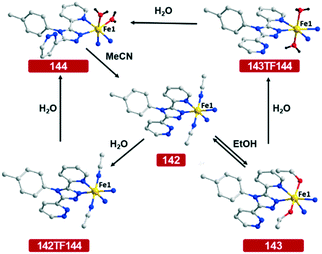 |
| | Fig. 50 The CP 142 is shown to undergo a series of reversible SCSC transformations upon exposure to a variety of solvent vapors. Reproduced from ref. 77. Copyright 2016, Wiley-VCH. | |
Vapor-diffusion-mediated SCSC transformation of a discrete dimeric [Cu(μ2-hep)(TFA)(H2O)]2 (145, hep-H = 2-(2-hydroxyethyl)pyridine, TFA-H = trifluoroacetic acid) to a discrete tetrameric [Cu4(μ3-hep)2(μ2-hep)2(μ2-TFA)2(TFA)2] (146) has been observed in the presence of EtOH vapor (Fig. 51).78 The EtOH vapor acts as a structure-directing agent in such a SCSC transformation. CPs 145 and 146 crystallize in the monoclinic C2/c and P21/n space group, respectively. 145 possesses hydrogen bonds in two forms of Owater–H⋯OTFA and Owater–H⋯Ohep. After the removal of coordinated H2O molecule, new Cu–OTFA and Cu–Ohep bonds are formed without change in CN (pathway II). The CuII in 145 is in a penta-coordinated CuO4N environment, whereas the transformed product tetrameric 146 has two types of CuII centres (square-pyramidal Cu atoms with CuO4N).
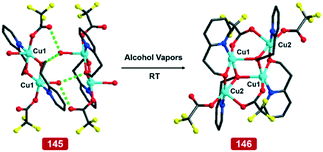 |
| | Fig. 51 The structural transformation of a dimer to a tetramer via removal of H2O molecules. Reproduced with permission from ref. 78. Copyright 2009, American Chemical Society. | |
Zhang et al. reported a vapor-induced reversible SC–SC transformation between dinuclear [Cu2L2(NO3)2]·CH3CN (147) and 1D {[CuL(H2O)](NO3)}n (148) (Fig. 52).79 Cyan plate 147 shows a paddle wheel structure typical for copper carboxylates, and the CuII is in a slightly distorted CuO5 square-pyramidal geometry with τ = 0.002, in which one oxygen atom of monodentate nitrate resides at the apical position. When 147 was exposed to water vapor, light blue block crystals of 148 were obtained ten minutes later. In 148, there are two independent CuII ions sitting on the inversion centres, and each of them is hexa-coordinated in a distorted CuO6 octahedral environment. The Cu1 bonded to four carboxylate oxygen atoms in the basal plane and two water oxygen atoms in the apical axis, and the Cu2 is bonded by four carboxylate oxygen atoms and two water oxygen atoms, and the axial positions are occupied by two carboxylate O atoms.
 |
| | Fig. 52 The SCSC transformation between 147 and 148. Reproduced with permission from ref. 79. Copyright 2017, the Royal Society of Chemistry. | |
A dark blue crystal of 2D {[Cu(IBA)2]·2DMF}n (149, HIBA = 4-(1H-imidazol-1-yl)benzoic acid) was converted to a cyan crystal of 2D {[Cu(IBA)2·H2O]·2H2O}n (150) upon exposure to air through an irreversible SCSC transformation, which is confirmed by SC-XRD, PXRD, TG and IR (Fig. 53).14 In 149, there are two crystallographically independent CuII ions, and both CuII are trans-coordinated with a square-planar coordination of nitrogen and oxygen atoms from four IBA−. Note that the remaining carboxylate oxygen atoms are only weakly interacting with the Cu centre. During this transformation, the crystal system and space group change from monoclinic space group P21/n in 149 to orthorhombic space group Pbcn in 150. In 150, the layers are retained as in 149 except that the two weakly coordinating carboxylate oxygen atoms in axial positions are replaced by one water oxygen molecule (CN = 4 and 5 for 149 and 150, respectively), resulting in a slightly distorted square pyramid. Fluorescence spectra measurements show that 149 can selectively and sensitively detect Fe3+ and 3-iodobromobenzene.
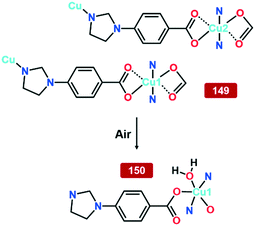 |
| | Fig. 53 The irreversible SCSC transformations between 149 and 150. Reproduced from ref. 14. Copyright 2019, Wiley-VCH. | |
Hatakeyama et al. reported a vapor-induced reversible SCSC transformation between 3D CP [Cu(HL)(DMSO)·(MeOH)]n (151, H3L = triphosphaazatriangulene) and 1D-columnar assembled material H3L·0.5[Cu2(OH)4·6H2O]·4H2O (152) (Fig. 54).84151 crystallizes in the monoclinic space group P21/n, and each CuII ion is trigonal-bipyramidally coordinated to the four HL2− O atoms and one DMSO oxygen atom. When 151 was exposed to water vapor, the water molecules attack the coordination sites of CuII ions, resulting in three aquo and two hydroxo ligands replacing the cleaved coordinating phosphonate groups and DMSO to maintain a trigonal-bipyramidal geometry, further forming edge-sharing octahedral dimers. CP 151 exhibits reversible MeOH-sorption characteristics, while 152 shows high proton conductivity.
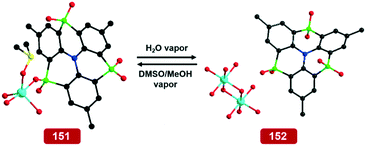 |
| | Fig. 54 The reversible SCSC transformations between 151 and 152. Reproduced from ref. 84. Copyright 2020, Wiley-VCH. | |
5. Conclusion and outlook
In this review, we have presented recent efforts to enhance the understanding of the effect of coordinated solvent molecules on the metal coordination environments of coordination polymers in SCSC fashion, which can provide new insights into the rational design and construction of CPs with desired structures and properties. There are two change pathways for the metal coordination environment: (I) both CN and CG change; (II) CG changes, but CN does not. Also, the structural transformations involve the retention of the framework structures or supramolecular structure (A) and the change in the framework structures or supramolecular structure (B) with the breakage or formation of coordination bonds. In addition, to better establish the relationship between external factors and structural transformations, different stimuli, including heat treatment, immersion in solvent solution or mother liquid, and vapor diffusion technique have been discussed. Heat treatment is the pre-eminent method to achieve reactions on the metal centres, and the breakage or formation of the coordination bonds results in changes in the coordination sphere. The removal/adsorption of coordinated H2O is the most common in the thermally induced SCSC transformation. However, for solvent or vapor exchange, it remains a challenge to engage externally introduced guest ligands to affect the substitution process at the metal centre, because the mechanisms behind most transformations still remain unclear and out of control. Most studies so far have been at the test stage and do not involve a controllable process. Thus, in the future, much effort must be invested for probing the laws of solvent/vapor exchange induced structural conversion and transforming a huge quantity of data into rules. In addition, various computational chemistry-based theories, methodologies and technologies might provide new opportunities for understanding the mechanisms of SCSC transformations and the design of more functional materials. In addition, we have tried our best to incorporate all such papers and we do apologize if any significant contribution has escaped our attention and not included here.
Conflicts of interest
There are no conflicts to declare.
Acknowledgements
This work was supported by the NSF of China (No. 21673173, 21531007, 21807087 and 51679200), the Key Research and Development Program of Shaanxi (No. 2019KWZ-07), the Key Science and Technology Innovation Team of Shaanxi Province (No. 2017KCT-37), the Xi'an City Science and Technology Project (No. 2019218214GXRC018CG019-GXYD18.4), the Technology Innovation Leading Program of Shaanxi (No. 2020TG-031), the Science and Technology Project of Shaanxi Provincial Water Resources Department (No. 2018slkj-12), and the “Top-rated Discipline” construction scheme of Shaanxi higher education.
References
- E. J. Carrington, C. A. McAnally, A. J. Fletcher, S. P. Thompson, M. Warren and L. Brammer, Nat. Chem., 2017, 9, 882–889 CrossRef CAS
 .
.
- S. Shi, M. C. Jung, C. Coburn, A. Tadle, M. R. D. Sylvinson, P. I. Djurovich, S. R. Forrest and M. E. Thompson, J. Am. Chem. Soc., 2019, 141, 3576–3588 CrossRef CAS
 .
.
- C. P. Li and M. Du, Chem. Commun., 2011, 47, 5958–5972 RSC
 .
.
- Y. S. Wei, M. Zhang, M. Kitta, Z. Liu, S. Horike and Q. Xu, J. Am. Chem. Soc., 2019, 141, 7906–7916 CrossRef CAS
 .
.
- W. Liang, H. Xu, F. Carraro, N. K. Maddigan, Q. Li, S. G. Bell, D. M. Huang, A. Tarzia, M. B. Solomon, H. Amenitsch, L. Vaccari, C. J. Sumby, P. Falcaro and C. J. Doonan, J. Am. Chem. Soc., 2019, 141, 2348–2355 CrossRef CAS
 .
.
- Y. Li, X. Wang, C. Y. Xing, X. R. Zhang, Z. Liang, X. K. Wang, K. Zhang, Y. T. Wang, D. Liu, W. D. Fan and F. N. Dai, Chin. Chem. Lett., 2019, 30, 1440–1444 CrossRef CAS
 .
.
- S. A. M. Wehlin, L. Troian-Gautier, R. N. Sampaio, L. Marcélis and G. J. Meyer, J. Am. Chem. Soc., 2018, 140, 7799–7802 CrossRef CAS
 .
.
- Y. P. Xia, C. X. Wang, M. H. Yu and X. H. Bu, Chin. Chem. Lett., 2020 DOI:10.1016/j.cclet.2020.09.014
 .
.
- C. C. Cao, C. X. Chen, Z. W. Wei, Q. F. Qiu, N. X. Zhu, Y. Y. Xiong, J. J. Jiang, D. W. Wang and C. Y. Su, J. Am. Chem. Soc., 2019, 141, 2589–2593 CrossRef CAS
 .
.
- X. D. Huang, Y. Xu, K. Fan, S. S. Bao, M. Kurmoo and L. M. Zheng, Angew. Chem., Int. Ed., 2018, 57, 8577–8581 CrossRef CAS
 .
.
- J. H. Wang, Y. Zhang, M. Li, S. Yan, D. Li and X. M. Zhang, Angew. Chem., Int. Ed., 2017, 56, 6478–6482 CrossRef CAS
 .
.
- J. J. Vittal and H. S. Quah, Coord. Chem. Rev., 2017, 342, 1–18 CrossRef CAS
 .
.
- Q. Q. Li, C. Y. Ren, Y. Y. Huang, J. L. Li, P. Liu, B. Liu, Y. Liu and Y. Y. Wang, Chemistry, 2015, 21, 4703–4711 CrossRef CAS
 .
.
- Y. Zhu, S. Durini, P. Lönnecke, M. Cong and E. Hey-Hawkins, ChemistrySelect, 2019, 4, 8195–8200 CrossRef CAS
 .
.
- X. L. Liu, W. W. Fan, Z. X. Lu, Y. Qin, S. X. Yang, Y. Li, Y. X. Liu, L. Y. Zheng and Q. E. Cao, Chemistry, 2019, 25, 5787–5792 CrossRef CAS
 .
.
- F. Yu, J. Q. Li, M. Kurmoo and J.-L. Zuo, Inorg. Chem., 2018, 57, 15040–15043 CrossRef CAS
 .
.
- M. H. Zeng, Y. X. Tan, Y. P. He, Z. Yin, Q. Chen and M. Kurmoo, Inorg. Chem., 2013, 52, 2353–2360 CrossRef CAS
 .
.
- J. G. Yu, M.-M. Gan, S. Bai and Y.-F. Han, CrystEngComm, 2019, 21, 4673–4683 RSC
 .
.
- A. Chaudhary, A. Mohammad and S. M. Mobin, Cryst. Growth Des., 2017, 17, 2893–2910 CrossRef CAS
 .
.
- L. Aboutorabi and A. Morsali, Coord. Chem. Rev., 2016, 310, 116–130 CrossRef CAS
 .
.
- G. K. Kole and J. J. Vittal, Chem. Soc. Rev., 2013, 42, 1755–1775 RSC
 .
.
- K. K. Tanabe and S. M. Cohen, Chem. Soc. Rev., 2011, 40, 498–519 RSC
 .
.
- J. J. Vittal, Coord. Chem. Rev., 2007, 251, 1781–1795 CrossRef CAS
 .
.
- M. Kawano and M. Fujita, Coord. Chem. Rev., 2007, 251, 2592–2605 CrossRef CAS
 .
.
- Q. Pang, B. Tu and Q. Li, Dalton Trans., 2019, 48, 12000–12008 RSC
 .
.
- D. Q. Wu, D. Shao, X.-Q. Wei, F. X. Shen, L. Shi, D. Kempe, Y. Z. Zhang, K. R. Dunbar and X. Y. Wang, J. Am. Chem. Soc., 2017, 139, 11714–11717 CrossRef CAS
 .
.
- R. Singh, J. Mrozinski and P. K. Bharadwaj, Cryst. Growth Des., 2014, 14, 3623–3633 CrossRef CAS
 .
.
- T. Kundu, M. Wahiduzzaman, B. B. Shah, G. Maurin and D. Zhao, Angew. Chem., Int. Ed., 2019, 58, 8073–8077 CrossRef CAS
 .
.
- L. Ma and W. Lin, J. Am. Chem. Soc., 2008, 130, 13834–13835 CrossRef CAS
 .
.
- J. B. Lin, J. P. Zhang, W. X. Zhang, W. Xue, D. X. Xue and X. M. Chen, Inorg. Chem., 2009, 48, 6652–6660 CrossRef CAS
 .
.
- X. Y. Wang, L. Wang, Z. M. Wang and S. Gao, J. Am. Chem. Soc., 2006, 128, 674–675 CrossRef CAS
 .
.
- X. C. Huang, J. P. Zhang, Y. Y. Lin and X. M. Chen, Chem. Commun., 2005, 2232–2234 RSC
 .
.
- W. Q. Zhang, W. Y. Zhang, R. D. Wang, C. Y. Ren, Q. Q. Li, Y. P. Fan, B. Liu, P. Liu and Y. Y. Wang, Cryst. Growth Des., 2017, 17, 517–526 CrossRef CAS
 .
.
- D. Sarma, K. V. Ramanujachary, S. E. Lofland, T. Magdaleno and S. Natarajan, Inorg. Chem., 2009, 48, 11660–11676 CrossRef CAS
 .
.
- C. L. Chen, A. M. Goforth, M. D. Smith, C. Y. Su and H. C. zur Loye, Angew. Chem., Int. Ed., 2005, 44, 6673–6677 CrossRef CAS
 .
.
- N. C. Jeong, B. Samanta, C. Y. Lee, O. K. Farha and J. T. Hupp, J. Am. Chem. Soc., 2012, 134, 51–54 CrossRef CAS
 .
.
- Q. Zhou, F. Yang, B. Xin, G. Zeng, X. Zhou, K. Liu, D. Ma, G. Li, Z. Shi and S. Feng, Chem. Commun., 2013, 49, 8244–8246 RSC
 .
.
- J. Jiang, K. Fang, J. Q. Li, M. X. Li, M. Shao and X. He, Polyhedron, 2019, 170, 564–569 CrossRef CAS
 .
.
- G. C. Lv, P. Wang, Q. Liu, J. Fan, K. Chen and W. Y. Sun, Chem. Commun., 2012, 48, 10249–10251 RSC
 .
.
- M. J. Manos, E. J. Kyprianidou, G. S. Papaefstathiou and A. J. Tasiopoulos, Inorg. Chem., 2012, 51, 6308–6314 CrossRef CAS
 .
.
- C. G. Efthymiou, E. J. Kyprianidou, C. J. Milios, M. J. Manos and A. J. Tasiopoulos, J. Mater. Chem. A, 2013, 1, 5061–5069 RSC
 .
.
- J. Vallejo, E. Pardo, M. Viciano-Chumillas, I. Castro, P. Amorós, M. Déniz, C. Ruiz-Pérez, C. Yuste-Vivas, J. Krzystek, M. Julve, F. Lloret and J. Cano, Chem. Sci., 2017, 8, 3694–3702 RSC
 .
.
- S. Bhattacharya and S. Natarajan, Z. Anorg. Allg. Chem., 2014, 640, 2922–2930 CrossRef CAS
 .
.
- M. C. Das and P. K. Bharadwaj, J. Am. Chem. Soc., 2009, 131, 10942–10949 CrossRef CAS
 .
.
- S. K. Ghosh, J.-P. Zhang and S. Kitagawa, Angew. Chem., Int. Ed., 2007, 46, 7965–7968 CrossRef CAS
 .
.
- A. Aslani and A. Morsali, Chem. Commun., 2008, 3402–3404 RSC
 .
.
- L. Wen, P. Cheng and W. Lin, Chem. Commun., 2012, 48, 2846–2848 RSC
 .
.
- M. H. Zeng, S. Hu, Q. Chen, G. Xie, Q. Shuai, S. L. Gao and L. Y. Tang, Inorg. Chem., 2009, 48, 7070–7079 CrossRef CAS
 .
.
- X. P. Zhou, Z. Xu, M. Zeller, A. D. Hunter, S. S. Chui and C. M. Che, Inorg. Chem., 2011, 50, 7142–7149 CrossRef CAS
 .
.
- Z. Su, M. Chen, T. A. Okamura, M. S. Chen, S. S. Chen and W. Y. Sun, Inorg. Chem., 2011, 50, 985–991 CrossRef CAS
 .
.
- X. N. Cheng, W. X. Zhang, Y. Y. Lin, Y. Z. Zheng and X. M. Chen, Adv. Mater., 2007, 19, 1494–1498 CrossRef CAS
 .
.
- Y. J. Zhang, T. Liu, S. Kanegawa and O. Sato, J. Am. Chem. Soc., 2009, 131, 7942–7943 CrossRef CAS
 .
.
- K. Akhbari and A. Morsali, CrystEngComm, 2013, 15, 8915–8918 RSC
 .
.
- G. D. Zou, Z. Z. He, C. B. Tian, L. J. Zhou, M. L. Feng, X. D. Zhang and X. Y. Huang, Cryst. Growth Des., 2014, 14, 4430–4438 CrossRef CAS
 .
.
- S. K. Ghosh, W. Kaneko, D. Kiriya, M. Ohba and S. Kitagawa, Angew. Chem., Int. Ed., 2008, 47, 8843–8847 CrossRef CAS
 .
.
- A. Aslani, A. Morsali and M. Zeller, Dalton Trans., 2008, 5173–5177 RSC
 .
.
- Y. Fu, J. Su, S. Yang, Z. Zou, G. Li, F. Liao, M. Xiong and J. Lin, Cryst. Growth Des., 2011, 11, 2243–2249 CrossRef CAS
 .
.
- S. B. Choi, H. Furukawa, H. J. Nam, D. Y. Jung, Y. H. Jhon, A. Walton, D. Book, M. O'Keeffe, O. M. Yaghi and J. Kim, Angew. Chem., Int. Ed., 2012, 51, 8791–8795 CrossRef CAS
 .
.
- M. K. Sharma and P. K. Bharadwaj, Inorg. Chem., 2011, 50, 1889–1897 CrossRef CAS
 .
.
- S. Bhattacharya, A. J. Bhattacharyya and S. Natarajan, Inorg. Chem., 2015, 54, 1254–1271 CrossRef CAS
 .
.
- Y. Q. Lan, H. L. Jiang, S. L. Li and Q. Xu, Inorg. Chem., 2012, 51, 7484–7491 CrossRef CAS
 .
.
- Z. Ju and D. Yuan, CrystEngComm, 2013, 15, 9513 RSC
 .
.
- E. J. Kyprianidou, T. Lazarides, S. Kaziannis, C. Kosmidis, G. Itskos, M. J. Manos and A. J. Tasiopoulos, J. Mater. Chem. A, 2014, 2, 5258 RSC
 .
.
- T. Qin, J. Gong, J. Ma, X. Wang, Y. Wang, Y. Xu, X. Shen and D. Zhu, Chem. Commun., 2014, 50, 15886–15889 RSC
 .
.
- Z. J. Guo, J. M. Yu, Y. Z. Zhang, J. Zhang, Y. Chen, Y. F. Wu, L. H. Xie and J. R. Li, Inorg. Chem., 2017, 56, 2188–2197 CrossRef CAS
 .
.
- W. Huang, F. X. Shen, S. Q. Wu, L. Liu, D. Wu, Z. Zheng, J. Xu, M. Zhang, X. C. Huang, J. Jiang, F. Pan, Y. Li, K. Zhu and O. Sato, Inorg. Chem., 2016, 55, 5476–5484 CrossRef CAS
 .
.
- J. J. Wu, Y. X. Ye, Y. Y. Qiu, Z. P. Qiao, M. L. Cao and B. H. Ye, Inorg. Chem., 2013, 52, 6450–6456 CrossRef CAS
 .
.
- J. Jiang, Z. H. Ma, R. Liu and X. He, Inorg. Chim. Acta, 2020, 501, 119241 CrossRef CAS
 .
.
- C. B. Ma, M. Q. Hu, H. Chen, M. Wang, C. X. Zhang, C. N. Chen and Q. T. Liu, CrystEngComm, 2010, 12, 1467–1473 RSC
 .
.
- H. Li, X. Fang, S. Ma, Y. Niu, X. Zhao, J. Xu and Z. Duan, Dalton Trans., 2017, 46, 8350–8353 RSC
 .
.
- J. Y. Liu, Q. Wang, L. J. Zhang, B. Yuan, Y. Y. Xu, X. Zhang, C. Y. Zhao, D. Wang, Y. Yuan, Y. Wang, B. Ding, X. J. Zhao and M. M. Yue, Inorg. Chem., 2014, 53, 5972–5985 CrossRef CAS
 .
.
- Z. Y. Liu, E. C. Yang, L. L. Li and X. J. Zhao, Dalton Trans., 2012, 41, 6827 RSC
 .
.
- Y. Huang, J. Zhang, D. Yue, Y. Cui, Y. Yang, B. Li and G. Qian, Chem. – Eur. J., 2018, 24, 13231–13237 CrossRef CAS
 .
.
- S. S. Feng, Y. T. Bai, J. L. Zhu, L. P. Lu and M. L. Zhu, Spectrochim. Acta, Part A, 2018, 205, 139–145 CrossRef CAS
 .
.
- Y. Wang, S. S. Meng, P. X. Lin, Y. W. Xiao, Q. Q. Ma, Q. Xie, Y. Y. Chen, X. J. Zhao and J. Chen, Inorg. Chem., 2016, 55, 4069–4071 CrossRef CAS
 .
.
- C. R. Murdock, Z. Lu and D. M. Jenkins, Dalton Trans., 2012, 41, 7839–7841 RSC
 .
.
- S. Rodriguez-Jimenez, H. L. Feltham and S. Brooker, Angew. Chem., Int. Ed., 2016, 55, 15067–15071 CrossRef CAS
 .
.
- S. M. Mobin, A. K. Srivastava, P. Mathur and G. K. Lahiri, Inorg. Chem., 2009, 48, 4652–4654 CrossRef CAS
 .
.
- Y. F. Feng, Q. Tang, K. L. Luo, J. Q. Wu, Z. Zhang, Y. N. Liang and F.-P. Liang, CrystEngComm, 2017, 19, 5442–5459 RSC
 .
.
- P. Kar, M. Yoshida, Y. Shigeta, A. Usui, A. Kobayashi, T. Minamidate, N. Matsunaga and M. Kato, Angew. Chem., Int. Ed., 2017, 56, 2345–2349 CrossRef CAS
 .
.
- A. Das, F. J. Klinke, S. Demeshko, S. Meyer, S. Dechert and F. Meyer, Inorg. Chem., 2012, 51, 8141–8149 CrossRef CAS
 .
.
- D. L. Reger, J. J. Horger and M. D. Smith, Chem. Commun., 2011, 47, 2805–2807 RSC
 .
.
- S. Supriya and S. K. Das, J. Am. Chem. Soc., 2007, 129, 3464–3465 CrossRef CAS
 .
.
- S. Nakatsuka, Y. Watanabe, Y. Kamakura, S. Horike, D. Tanaka and T. Hatakeyama, Angew. Chem., Int. Ed., 2020, 59, 1435–1439 CrossRef CAS
 .
.
|
| This journal is © The Royal Society of Chemistry 2020 |
 *a,
Jin-Xi
Song
*b and
Yao-Yu
Wang
*a,
Jin-Xi
Song
*b and
Yao-Yu
Wang
 a
a






![[1 with combining macron]](https://www.rsc.org/images/entities/char_0031_0304.gif) , and there are two crystallographically independent MII ions (M = Co and Ni). Both metal ions have a distorted octahedral coordination formed by three carboxylate oxygens, one N from the AIP anion, one N from the pyz ligand, and one coordinated H2O molecule (CN = 6). Heating at 125 °C of 7 and 8 produces the dehydrated 2D [Co2(AIP)2(pyz)] (9) and [Ni2(AIP)2(pyz)] (10), which are also isostructural but undergo a crystal system transformation from parent triclinic (9 and 10) to monoclinic (space group C2/c, 9 and 10). 9 and 10 also retain the structural integrity of the parent phase as there is very little change in the bilayer arrangement. The metal ions are coordinated by three carboxylate oxygens, one N from the AIP anion, and one N from the pyz ligand, forming a distorted square pyramidal environment (MO3N2, CN = 5) (pathway I). When heating at 80 °C, 7 and 8 can transform into [Co2(AIP)2(pyz)(H2O)]·H2O (11) and [Ni2(AIP)2(pyz)(H2O)]·H2O (12), respectively. In 11 and 12, one of the two metal ions loses the coordinated H2O molecule (becomes distorted square pyramidal), while the other metal ion continues to be in the octahedral environment and eventually loses the bonded water molecules when heated to 125 °C. In addition, the water molecules of 7 and 8 can be replaced by D2O when soaking in D2O, producing 13 and 14 without change in metal CN (pathway II), respectively.
, and there are two crystallographically independent MII ions (M = Co and Ni). Both metal ions have a distorted octahedral coordination formed by three carboxylate oxygens, one N from the AIP anion, one N from the pyz ligand, and one coordinated H2O molecule (CN = 6). Heating at 125 °C of 7 and 8 produces the dehydrated 2D [Co2(AIP)2(pyz)] (9) and [Ni2(AIP)2(pyz)] (10), which are also isostructural but undergo a crystal system transformation from parent triclinic (9 and 10) to monoclinic (space group C2/c, 9 and 10). 9 and 10 also retain the structural integrity of the parent phase as there is very little change in the bilayer arrangement. The metal ions are coordinated by three carboxylate oxygens, one N from the AIP anion, and one N from the pyz ligand, forming a distorted square pyramidal environment (MO3N2, CN = 5) (pathway I). When heating at 80 °C, 7 and 8 can transform into [Co2(AIP)2(pyz)(H2O)]·H2O (11) and [Ni2(AIP)2(pyz)(H2O)]·H2O (12), respectively. In 11 and 12, one of the two metal ions loses the coordinated H2O molecule (becomes distorted square pyramidal), while the other metal ion continues to be in the octahedral environment and eventually loses the bonded water molecules when heated to 125 °C. In addition, the water molecules of 7 and 8 can be replaced by D2O when soaking in D2O, producing 13 and 14 without change in metal CN (pathway II), respectively.
![[1 with combining macron]](https://www.rsc.org/images/entities/char_0031_0304.gif) space group, and both Co1 and Co2 are hexa-coordinated and show a distorted octahedral coordination geometry. Co1 is bonded to six carboxylate O atoms from BTEC4−. The Co2 centre is surrounded by three carboxylate O atoms from BTEC4−, two N atoms from L−, and one water O atom. CP 15 is heated at 160 °C to remove the lattice and coordinated H2O molecules, and CP 16 is obtained with the retention of the framework structure and packing mode, but the coordination geometry of Co2 changes from octahedron (CN = 6) to square pyramid (CN = 5) (pathway I). Furthermore, the dehydrated form 16 exhibits a highly selective adsorption of water molecules over N2, MeOH and EtOH.
space group, and both Co1 and Co2 are hexa-coordinated and show a distorted octahedral coordination geometry. Co1 is bonded to six carboxylate O atoms from BTEC4−. The Co2 centre is surrounded by three carboxylate O atoms from BTEC4−, two N atoms from L−, and one water O atom. CP 15 is heated at 160 °C to remove the lattice and coordinated H2O molecules, and CP 16 is obtained with the retention of the framework structure and packing mode, but the coordination geometry of Co2 changes from octahedron (CN = 6) to square pyramid (CN = 5) (pathway I). Furthermore, the dehydrated form 16 exhibits a highly selective adsorption of water molecules over N2, MeOH and EtOH.
![[3 with combining macron]](https://www.rsc.org/images/entities/char_0033_0304.gif) c, and there are three crystallographically independent octahedral CoII ions in the asymmetric unit. Co1 is coordinated by three O atoms from ip ligands and three μ3-OH groups; Co2 is surrounded by five oxygen atoms from ip ligands and one μ3-OH group; Co3 is coordinated to four carboxylate oxygen atoms, one μ3-OH group, and one H2O molecule. The K+ counterions are bound to four carboxylate oxygen atoms and two H2O molecules. Single crystals of 17 are heated at 120 °C to obtain dehydrated single crystals of [KCo7(OH)3(ip)6] (18) accompanied by a colour change from red to purple. After the removal of the lattice and coordinated H2O molecules, although the structures are similar, the metal coordination environments in 18 are very different from those in 17. Most remarkably, the octahedral environment of Co3 (CN = 6) in 17 has been changed to a tetrahedron (CN = 5) in 18 (pathway I), and the K+ ion is now only four-coordinated. Note that such a transformation is concomitant with reversible magnetic property change upon desorption/adsorption of guest molecules.
c, and there are three crystallographically independent octahedral CoII ions in the asymmetric unit. Co1 is coordinated by three O atoms from ip ligands and three μ3-OH groups; Co2 is surrounded by five oxygen atoms from ip ligands and one μ3-OH group; Co3 is coordinated to four carboxylate oxygen atoms, one μ3-OH group, and one H2O molecule. The K+ counterions are bound to four carboxylate oxygen atoms and two H2O molecules. Single crystals of 17 are heated at 120 °C to obtain dehydrated single crystals of [KCo7(OH)3(ip)6] (18) accompanied by a colour change from red to purple. After the removal of the lattice and coordinated H2O molecules, although the structures are similar, the metal coordination environments in 18 are very different from those in 17. Most remarkably, the octahedral environment of Co3 (CN = 6) in 17 has been changed to a tetrahedron (CN = 5) in 18 (pathway I), and the K+ ion is now only four-coordinated. Note that such a transformation is concomitant with reversible magnetic property change upon desorption/adsorption of guest molecules.





![[1 with combining macron]](https://www.rsc.org/images/entities/char_0031_0304.gif) to a monoclinic P21/c space group. In 32, there are two crystallographically independent PbII ions and both Pb1 and Pb2 are penta-coordinated. Pb1 is surrounded by three O atoms and one N atom from three 8-Quin ligands and one terminal NO3− anion, leading to a distorted square pyramid. Pb2 is bonded to two O atoms and one N atom from two 8-Quin ligands, one terminal NO3− anion, and one MeOH molecule, resulting in a distorted square pyramid. Upon heating at 165–170 °C, a new Pb–Onitrate bond is formed as a result of the CN change from 5 to 6 upon removal of MeOH (pathway I). In 33, each Pb center is hexa-coordinated by two O atoms and one N atom from two 8-Quin ligands, and three O atoms from two NO3− anions, resulting in a distorted octahedron coordination geometry. Such a transformation is also accompanied by a change in colour, dimension, phase and photoluminescence features.
to a monoclinic P21/c space group. In 32, there are two crystallographically independent PbII ions and both Pb1 and Pb2 are penta-coordinated. Pb1 is surrounded by three O atoms and one N atom from three 8-Quin ligands and one terminal NO3− anion, leading to a distorted square pyramid. Pb2 is bonded to two O atoms and one N atom from two 8-Quin ligands, one terminal NO3− anion, and one MeOH molecule, resulting in a distorted square pyramid. Upon heating at 165–170 °C, a new Pb–Onitrate bond is formed as a result of the CN change from 5 to 6 upon removal of MeOH (pathway I). In 33, each Pb center is hexa-coordinated by two O atoms and one N atom from two 8-Quin ligands, and three O atoms from two NO3− anions, resulting in a distorted octahedron coordination geometry. Such a transformation is also accompanied by a change in colour, dimension, phase and photoluminescence features.

![[1 with combining macron]](https://www.rsc.org/images/entities/char_0031_0304.gif) . CP 38 can transform to 39 upon stirring in water. In 38, each hexa-coordinated CoII adopts a distorted CoO4N2 octahedral geometry consisting of DNC oxygen atoms and 5,5′-dmbpy N atoms. Upon the attack of H2O, the Co–O bonds break while two H2O molecules coordinate to each CoII to fill the vacant sites to maintain the coordination geometry of CoII; finally, the 1D ladder-like chain in 38 splits into two 1D single chains in 39. In 39, there are two crystallographically independent CoII ions, and both of them are in a distorted octahedral coordination environment consisting of two 5,5′-dmbpy N atoms and two water O atoms in the equatorial plane and two DNC oxygen atoms in the axial sites. CP 39 can transform to 40 by heating in its mother solution produced by MW, and 40 can convert into 39 by stirring in its mother solution at room temperature. 40 crystallizes in the space group Pbca, and its asymmetric unit is similar to that of 38.
. CP 38 can transform to 39 upon stirring in water. In 38, each hexa-coordinated CoII adopts a distorted CoO4N2 octahedral geometry consisting of DNC oxygen atoms and 5,5′-dmbpy N atoms. Upon the attack of H2O, the Co–O bonds break while two H2O molecules coordinate to each CoII to fill the vacant sites to maintain the coordination geometry of CoII; finally, the 1D ladder-like chain in 38 splits into two 1D single chains in 39. In 39, there are two crystallographically independent CoII ions, and both of them are in a distorted octahedral coordination environment consisting of two 5,5′-dmbpy N atoms and two water O atoms in the equatorial plane and two DNC oxygen atoms in the axial sites. CP 39 can transform to 40 by heating in its mother solution produced by MW, and 40 can convert into 39 by stirring in its mother solution at room temperature. 40 crystallizes in the space group Pbca, and its asymmetric unit is similar to that of 38.

![[1 with combining macron]](https://www.rsc.org/images/entities/char_0031_0304.gif) . In 43, each octa-coordinated CeIII ion is surrounded by six carboxylate oxygen atoms from tci and two H2O molecules to give an overall distorted quadrangle prism. When 43 is heated at 150 °C, it loses all the H2O molecules and converts into the anhydrous product 44. After the removal of the lattice and coordinated H2O molecules, the cleavage of two Ce–Owater bonds and the formation of two new bonds (Ce–O3 and Ce–O4) occurred with the rearrangement of two additional bonds from one CeIII to the other (O5 and O9) without a change in CN (pathway II). The carboxylate oxygen atom (O9) is the key atom in the structural transformation from the 2D sheet to the 3D framework. The O9–Ce bond of one 2D sheet breaks and a bond reforms through coordination with the Ce centre of the next sheet, leading to the formation of the 3D structure. Thus, in 44, each CeIII ion is surrounded by eight oxygen atoms from tci ligands to result in a dodecahedron. In addition, 44 can also transform to 43 under H2O vapor.
. In 43, each octa-coordinated CeIII ion is surrounded by six carboxylate oxygen atoms from tci and two H2O molecules to give an overall distorted quadrangle prism. When 43 is heated at 150 °C, it loses all the H2O molecules and converts into the anhydrous product 44. After the removal of the lattice and coordinated H2O molecules, the cleavage of two Ce–Owater bonds and the formation of two new bonds (Ce–O3 and Ce–O4) occurred with the rearrangement of two additional bonds from one CeIII to the other (O5 and O9) without a change in CN (pathway II). The carboxylate oxygen atom (O9) is the key atom in the structural transformation from the 2D sheet to the 3D framework. The O9–Ce bond of one 2D sheet breaks and a bond reforms through coordination with the Ce centre of the next sheet, leading to the formation of the 3D structure. Thus, in 44, each CeIII ion is surrounded by eight oxygen atoms from tci ligands to result in a dodecahedron. In addition, 44 can also transform to 43 under H2O vapor.
![[1 with combining macron]](https://www.rsc.org/images/entities/char_0031_0304.gif) , and compared to 45, there are two similar but crystallographically distinct trinuclear CuII repeating units. The coordination environment around the CuII centres is changed, and all of them are changed from hexa-coordinated octahedral to tetra-coordinated square planar. All the coordinated H2O molecules are removed and the bridged hydroxy (O10) between Cu2 and Cu3 is cleaved. The μ3-O10 atoms are transformed to μ2-O10 atoms between Cu1 and Cu3, isolating Cu2 in terms of direct bridging by a single atom. In 46, the free carboxylate oxygen atoms (O4 and O5) of one 2D sheet are coordinated to Cu1 and Cu2 of the adjacent sheets on both sides, resulting in the transformation of the 2D sheets to the 3D framework. Such a reversible structural transformation is accompanied by a change in magnetic behaviour. The dry phase of 45 can absorb H2O molecules, but rejects organic solvents, such as MeOH, EtOH, acetone, and tetrahydrofuran.
, and compared to 45, there are two similar but crystallographically distinct trinuclear CuII repeating units. The coordination environment around the CuII centres is changed, and all of them are changed from hexa-coordinated octahedral to tetra-coordinated square planar. All the coordinated H2O molecules are removed and the bridged hydroxy (O10) between Cu2 and Cu3 is cleaved. The μ3-O10 atoms are transformed to μ2-O10 atoms between Cu1 and Cu3, isolating Cu2 in terms of direct bridging by a single atom. In 46, the free carboxylate oxygen atoms (O4 and O5) of one 2D sheet are coordinated to Cu1 and Cu2 of the adjacent sheets on both sides, resulting in the transformation of the 2D sheets to the 3D framework. Such a reversible structural transformation is accompanied by a change in magnetic behaviour. The dry phase of 45 can absorb H2O molecules, but rejects organic solvents, such as MeOH, EtOH, acetone, and tetrahydrofuran.






![[1 with combining macron]](https://www.rsc.org/images/entities/char_0031_0304.gif) and contains centrosymmetric, line trinuclear CoII aqua clusters (Co1–O–Co2–O–Co1). Both hexa-coordinated CoII centres adopt an octahedral geometry, Co1 is bound by two carboxylate O atoms from TCPSB, two water O molecules, one DMF oxygen atom, and one bipy N atom. Co2 is bound by four carboxylate O atoms from TCPSB and two μ2-H2O oxygen atoms. Immersion of 63 in MeCN solution results in 64 which can further transform into a new phase 65 after being exposed to air. During this transformation, the coordinated DMF/MeCN molecules are replaced by MeCN/H2O with no change in CN of the Co centres (pathway II). Lastly, CP 65 can convert into 63 upon immersing in DMF.
and contains centrosymmetric, line trinuclear CoII aqua clusters (Co1–O–Co2–O–Co1). Both hexa-coordinated CoII centres adopt an octahedral geometry, Co1 is bound by two carboxylate O atoms from TCPSB, two water O molecules, one DMF oxygen atom, and one bipy N atom. Co2 is bound by four carboxylate O atoms from TCPSB and two μ2-H2O oxygen atoms. Immersion of 63 in MeCN solution results in 64 which can further transform into a new phase 65 after being exposed to air. During this transformation, the coordinated DMF/MeCN molecules are replaced by MeCN/H2O with no change in CN of the Co centres (pathway II). Lastly, CP 65 can convert into 63 upon immersing in DMF.
![[1 with combining macron]](https://www.rsc.org/images/entities/char_0031_0304.gif) . In 66, each CdII ion is a distorted octahedron coordinated with four equatorial N of azim and two axial DMF oxygen atoms. In 67, all lattice and coordinated DMF molecules are replaced by an equal number of DEF molecules without a change in structure and CN of CdII (pathway II), leading to a CdO2N4 octahedral coordination geometry.
. In 66, each CdII ion is a distorted octahedron coordinated with four equatorial N of azim and two axial DMF oxygen atoms. In 67, all lattice and coordinated DMF molecules are replaced by an equal number of DEF molecules without a change in structure and CN of CdII (pathway II), leading to a CdO2N4 octahedral coordination geometry.




![[1 with combining macron]](https://www.rsc.org/images/entities/char_0031_0304.gif) ).
).




![[1 with combining macron]](https://www.rsc.org/images/entities/char_0031_0304.gif) and C2/c space group, respectively. SC-XRD reveals that the CGs of EuIII in 104 and 105 are similar and can be described as a distorted tricapped trigonal prism with six oxygen atoms and three N atoms. The difference between them is that one water molecule and one oxygen atom from an OBPT ligand complete the coordination sphere in 104, whereas two DMF molecules complete the coordination sphere in 105. Luminescence measurement revealed that the photoluminescence intensity of 105 is stronger than that of 104.
and C2/c space group, respectively. SC-XRD reveals that the CGs of EuIII in 104 and 105 are similar and can be described as a distorted tricapped trigonal prism with six oxygen atoms and three N atoms. The difference between them is that one water molecule and one oxygen atom from an OBPT ligand complete the coordination sphere in 104, whereas two DMF molecules complete the coordination sphere in 105. Luminescence measurement revealed that the photoluminescence intensity of 105 is stronger than that of 104.
![[1 with combining macron]](https://www.rsc.org/images/entities/char_0031_0304.gif) and C2/m, respectively. 108 has two types of Cu centres, whereas the transformed product 109 has one type of Cu centre. In 108, penta-coordinated Cu1 shows a distorted square pyramidal coordination geometry completed by three carboxyl atoms from HL3− and two py N atoms. Tetra-coordinated Cu2 exhibits a square planar geometry completed by two carboxyl O atoms and two water O atoms. In 109, the hexa-coordinated octahedral CuII ion is surrounded by two carboxyl O atoms, two water O atoms, and two py N atoms. Such a conversion occurred with a change in metal CN and CG (pathway I). Furthermore, the size effect and π-π interactions between the aromatic rings in the 2D layers resulted in 109 having high response and good selectivity to benzene vapor.
and C2/m, respectively. 108 has two types of Cu centres, whereas the transformed product 109 has one type of Cu centre. In 108, penta-coordinated Cu1 shows a distorted square pyramidal coordination geometry completed by three carboxyl atoms from HL3− and two py N atoms. Tetra-coordinated Cu2 exhibits a square planar geometry completed by two carboxyl O atoms and two water O atoms. In 109, the hexa-coordinated octahedral CuII ion is surrounded by two carboxyl O atoms, two water O atoms, and two py N atoms. Such a conversion occurred with a change in metal CN and CG (pathway I). Furthermore, the size effect and π-π interactions between the aromatic rings in the 2D layers resulted in 109 having high response and good selectivity to benzene vapor.
![[1 with combining macron]](https://www.rsc.org/images/entities/char_0031_0304.gif) and P21/c, respectively. 110 possesses two types of symmetry-independent, but very similar linear trimetallic clusters with an inversion on hexa-coordinated Mn2 or Mn4 bridged by six carboxylate oxygens from ip ligands. The penta-coordinated Mn1 or Mn3 is bonded to three carboxylate oxygens from ip ligands and two N atoms from bipy ligands, resulting in a distorted square pyramidal coordination and a highly distorted trigonal bipyramidal coordination on Mn1 and Mn3, respectively. Different from the four crystallographically independent MnII ions in 110, in 111, there is only one independent MnII in the asymmetric unit, and each MnII displays a distorted MnN2O4 octahedral environment coordinated by the two carboxylate O atoms, two N atoms from a bipy ligand and two terminal H2O molecule. The metal coordination environment has been changed (pathway I).
and P21/c, respectively. 110 possesses two types of symmetry-independent, but very similar linear trimetallic clusters with an inversion on hexa-coordinated Mn2 or Mn4 bridged by six carboxylate oxygens from ip ligands. The penta-coordinated Mn1 or Mn3 is bonded to three carboxylate oxygens from ip ligands and two N atoms from bipy ligands, resulting in a distorted square pyramidal coordination and a highly distorted trigonal bipyramidal coordination on Mn1 and Mn3, respectively. Different from the four crystallographically independent MnII ions in 110, in 111, there is only one independent MnII in the asymmetric unit, and each MnII displays a distorted MnN2O4 octahedral environment coordinated by the two carboxylate O atoms, two N atoms from a bipy ligand and two terminal H2O molecule. The metal coordination environment has been changed (pathway I).

![[1 with combining macron]](https://www.rsc.org/images/entities/char_0031_0304.gif) , and each CuII lies in a crystallographic inversion centre. The central CuII ion is hexa-coordinated by two axial nitrate oxygen atoms and four equatorial N atoms from tatrz ligands, showing a slightly distorted octahedron. 115 is immersed in the H2O/MeOH of sodium perchlorate monohydrate and convert to 116 (monoclinic; space group P21/c), which further transforms to 117 (monoclinic; space group P21/c) by immersing 116 in DMF and 117 undergoes a solvent–ligand substitution reaction to yield 116. In isostructural 116 and 117, the central CuII ion lies in the inversion position, and two axial oxygen atoms are from two terminal coordinated H2O (116) /DMF (117), whereas in 115, two axial N atoms are from two NO3− anions (pathway II).
, and each CuII lies in a crystallographic inversion centre. The central CuII ion is hexa-coordinated by two axial nitrate oxygen atoms and four equatorial N atoms from tatrz ligands, showing a slightly distorted octahedron. 115 is immersed in the H2O/MeOH of sodium perchlorate monohydrate and convert to 116 (monoclinic; space group P21/c), which further transforms to 117 (monoclinic; space group P21/c) by immersing 116 in DMF and 117 undergoes a solvent–ligand substitution reaction to yield 116. In isostructural 116 and 117, the central CuII ion lies in the inversion position, and two axial oxygen atoms are from two terminal coordinated H2O (116) /DMF (117), whereas in 115, two axial N atoms are from two NO3− anions (pathway II).


![[1 with combining macron]](https://www.rsc.org/images/entities/char_0031_0304.gif) , and two crystallographically independent GdIII ions exist in the asymmetric unit. Both Gd1 and Gd2 show nine coordination with two chelated carboxylates, two chelated-bridged carboxylates, one DMF oxygen atom, and one water oxygen atom, giving an overall distorted monocapped square antiprismatic coordination geometry. When 122 is immersed in benzene at room temperature for 2 days, it forms 123 (monoclinic; group space P21/c). Compared to the coordination environment of GdIII in 122, the coordinated DMF molecules were all replaced by the H2O molecules, and three chelating/chelating-bridging carboxylates shift and are converted to a bridging carboxylate group in 123. When 122 is immersed in DCM for 2 days, it transformed into 124 (triclinic; space group P
, and two crystallographically independent GdIII ions exist in the asymmetric unit. Both Gd1 and Gd2 show nine coordination with two chelated carboxylates, two chelated-bridged carboxylates, one DMF oxygen atom, and one water oxygen atom, giving an overall distorted monocapped square antiprismatic coordination geometry. When 122 is immersed in benzene at room temperature for 2 days, it forms 123 (monoclinic; group space P21/c). Compared to the coordination environment of GdIII in 122, the coordinated DMF molecules were all replaced by the H2O molecules, and three chelating/chelating-bridging carboxylates shift and are converted to a bridging carboxylate group in 123. When 122 is immersed in DCM for 2 days, it transformed into 124 (triclinic; space group P![[1 with combining macron]](https://www.rsc.org/images/entities/char_0031_0304.gif) ). In 124, the CN of Gd1 and Gd2 remain the same as those of 122, but one of the chelating carboxylates in 122 undergoes a “carboxylate shift” and is transformed into the chelating-bridging carboxylate mode. Gd1 is bonded to seven O atoms from L, one DMF oxygen atom, and one water oxygen atom, while Gd2 is coordinated to eight oxygen atoms from L and one DMF oxygen atom. When 122 is dipped in DEF for 2 days, it forms 125 (monoclinic; space group P21/c), and 125 can also transform to 122 when it is immersed in a mixture of DMF and H2O. The coordination environment of the GdIII ion in 125 is different from that of 122 and is completed by six O atoms of L and one DEF oxygen atom, showing a distorted GdO7 mono-capped trigonal prismatic geometry.
). In 124, the CN of Gd1 and Gd2 remain the same as those of 122, but one of the chelating carboxylates in 122 undergoes a “carboxylate shift” and is transformed into the chelating-bridging carboxylate mode. Gd1 is bonded to seven O atoms from L, one DMF oxygen atom, and one water oxygen atom, while Gd2 is coordinated to eight oxygen atoms from L and one DMF oxygen atom. When 122 is dipped in DEF for 2 days, it forms 125 (monoclinic; space group P21/c), and 125 can also transform to 122 when it is immersed in a mixture of DMF and H2O. The coordination environment of the GdIII ion in 125 is different from that of 122 and is completed by six O atoms of L and one DEF oxygen atom, showing a distorted GdO7 mono-capped trigonal prismatic geometry.
![[3 with combining macron]](https://www.rsc.org/images/entities/char_0033_0304.gif) ) and 127 (monoclinic; space group P21/) are different. Upon stimulation by H2O, the trinuclear MnII clusters in 126 are destroyed and the lattice undergoes a rearrangement through the rotation of H2sdc and the breakage and reconstruction of Mn–O bonds, resulting in the mononuclear MnII octahedral polyhedron of 127. In addition, 127 can be developed as an excellent Pb2+ sensor in aqueous solution through the luminescence quenching effect.
) and 127 (monoclinic; space group P21/) are different. Upon stimulation by H2O, the trinuclear MnII clusters in 126 are destroyed and the lattice undergoes a rearrangement through the rotation of H2sdc and the breakage and reconstruction of Mn–O bonds, resulting in the mononuclear MnII octahedral polyhedron of 127. In addition, 127 can be developed as an excellent Pb2+ sensor in aqueous solution through the luminescence quenching effect.












.
.
.
.
.
.
.
.
.
.
.
.
.
.
.
.
.
.
.
.
.
.
.
.
.
.
.
.
.
.
.
.
.
.
.
.
.
.
.
.
.
.
.
.
.
.
.
.
.
.
.
.
.
.
.
.
.
.
.
.
.
.
.
.
.
.
.
.
.
.
.
.
.
.
.
.
.
.
.
.
.
.
.
.






